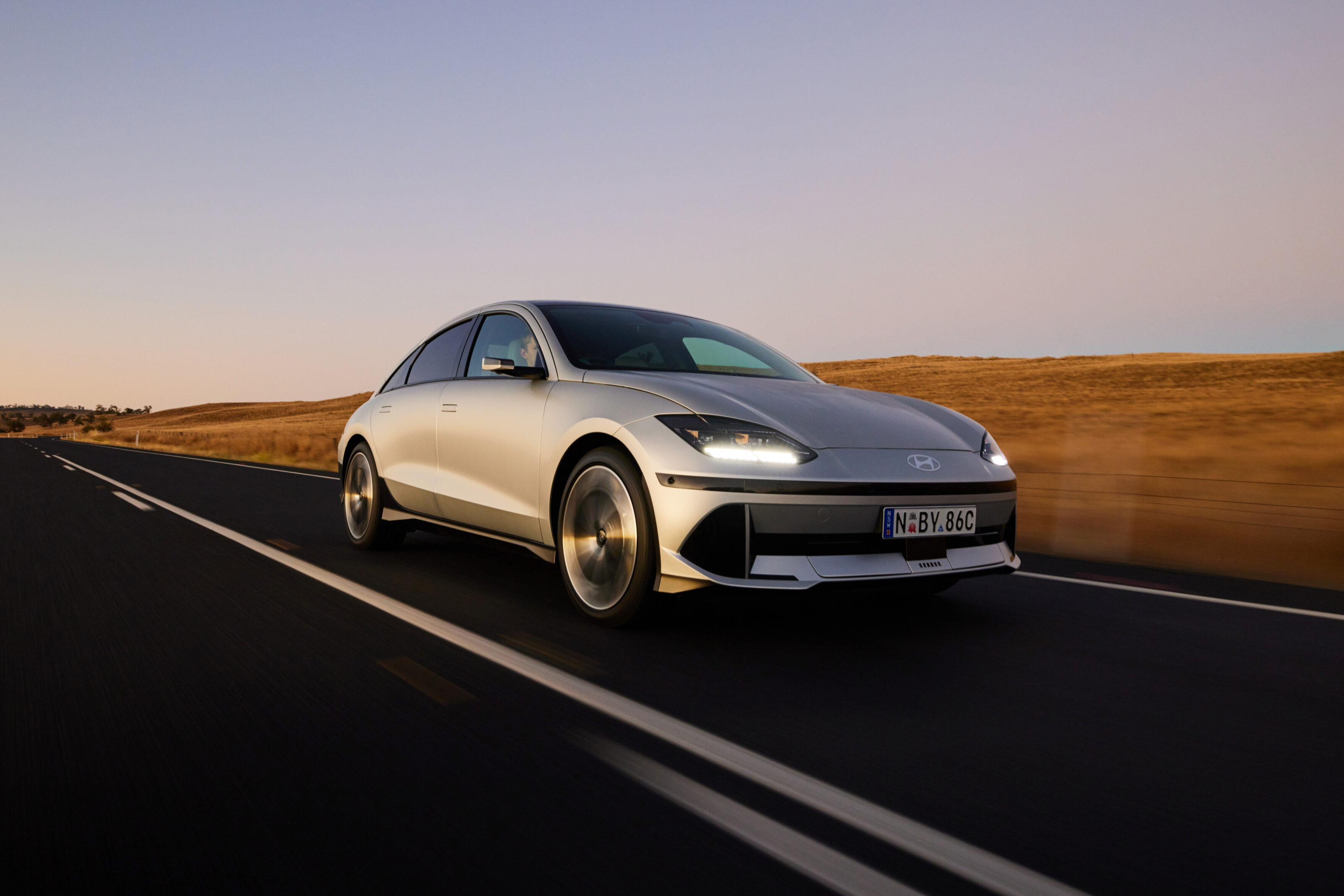Score breakdown
Things we like
- Overall refinement
- Ultra-fast charging
- Richly equipped
- Huge safety suite across all models
Not so much
- Pinched rear headroom
- Wired phone mirroring
- Intrusive driver aids
- Inflexible trim structure
This, or a Tesla Model 3? That’s the question you want answered about the Hyundai IONIQ 6 isn’t it?
Like most such questions, it’s usually the case that you’ve made your mind up already and are looking for confirmation – but this one is a little more nuanced.
We’ve waited a very long time for a drive in the IONIQ 6 on Aussie roads. The car was first teased as the Prophecy concept car back in March 2020. That car was due to be the highlight of Hyundai’s Geneva Show stand that year, before a certain global inconvenience intervened.
The productionised version was unveiled in June of 2022, dubbed the ‘electrified streamliner’. Hyundai’s design guru SangYup Lee described the interior as “a mindful cocoon”, contrasting with the airiness of the IONIQ 5 SUV with which the 6 shared its E-GMP underpinnings.
It forms part of an electrified product assault by Hyundai and, while coming to market with a sedan might seem curious when that sector feels as if it’s on the nose, the IONIQ 6 goes head-to-head with the massive selling Tesla Model 3 – delivering a tantalising alternative to the all-conquering American.
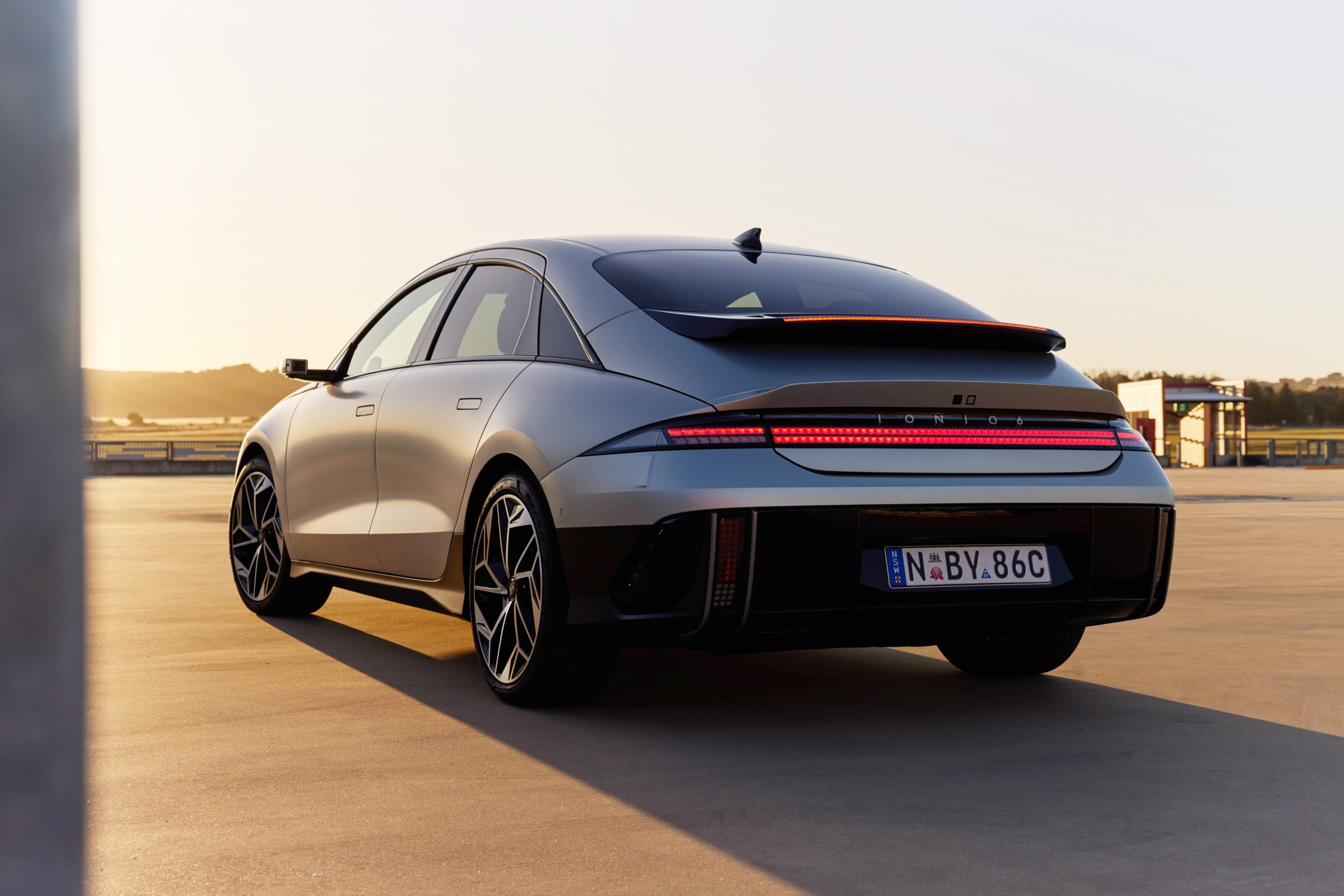
JUMP AHEAD
- How much is it, and what do you get?
- Where is this model in its lifecycle?
- How do rivals compare on value?
- Interior comfort, space and storage
- Technology in the cabin
- What is it like to drive?
- How much energy does it use?
- How safe is it?
- Warranty and running costs
- VERDICT
- Specifications
How much is it, and what do you get?
| 2023 Hyundai IONIQ Dynamiq features | |
|---|---|
| 18-inch alloy wheels | Head-up display |
| Dual 12.3-inch digital displays | 10-way powered driver and front passenger seats |
| Matrix adaptive LED headlamps | Wired Apple CarPlay/Android Auto |
| 8-speaker Bose audio system | Blue Link connected car services |
| Leather upholstery | Multi-Bluetooth connectivity |
The three-model range is easy to get to grips with. It opens with a single-motor, rear-drive version. Pay a little more and you can choose between a pair of more powerful dual-motor, all-wheel-drive variants.
Pricing kicks off at $74,000 (before on-road costs) for the 168kW/350Nm Dynamiq trim level.
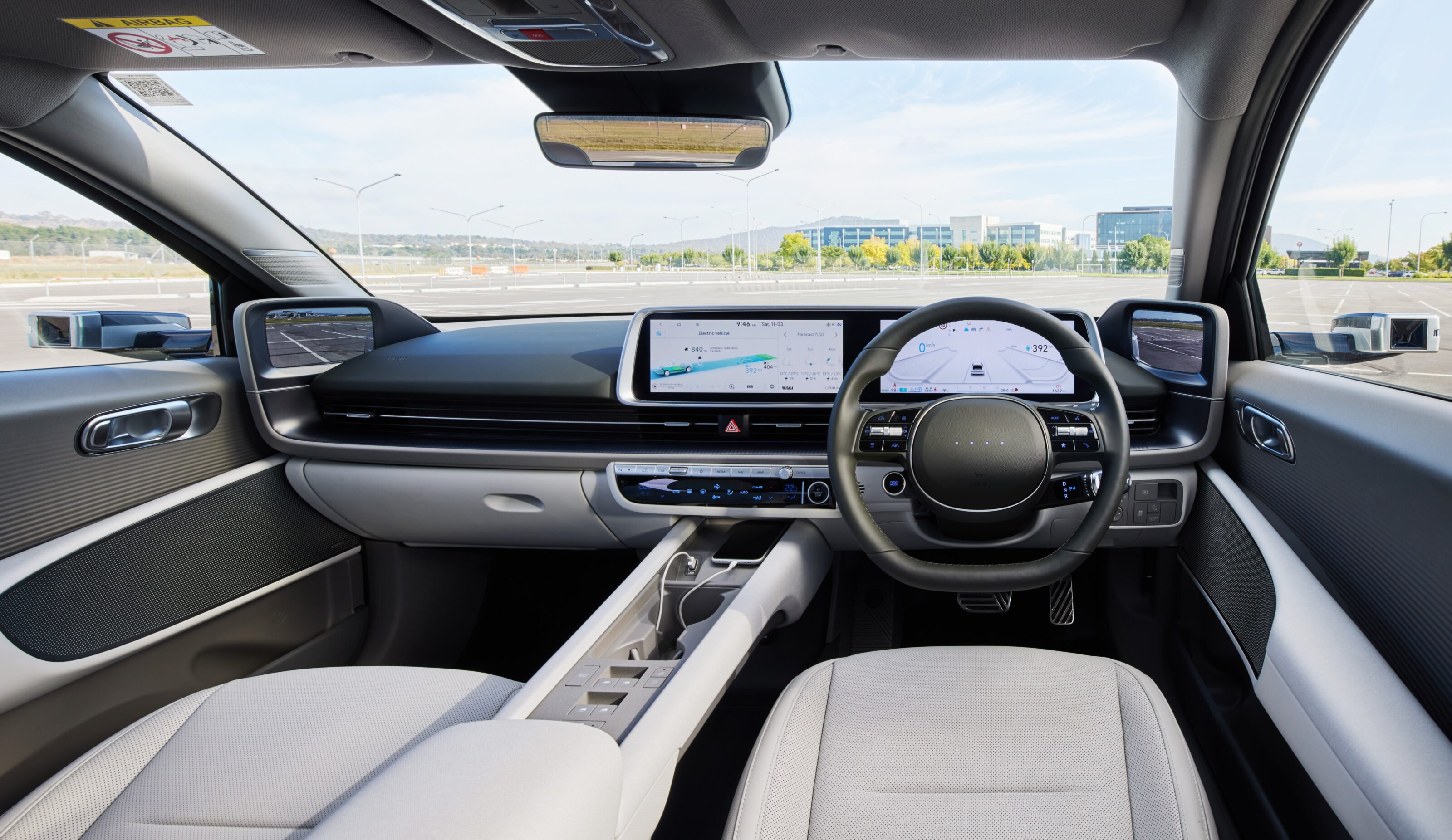
All versions of the IONIQ 6 use the same 77.4kWh battery pack, but given this is a single motor version riding on smaller wheels and tyres, it’s the lightest and most aerodynamic of all the IONIQ 6 variants (0.217cD) and therefore delivers the best range.
Hyundai claims a driving range of 614km for the Dynamiq. You’ll identify this model by its 18-inch alloy wheels.
Despite the fact it lacks the punch of the dual-motor versions, it’s hard to feel short-changed with the Dynamiq. Equipment that you might think would be reserved for the higher-spec versions, is right there on the standard equipment list.

That means you get gear like adaptive matrix headlights, leather trimmed seats, vehicle-to-load charging points both inside and outside the car, heated and powered front seats, a head-up display, a powered boot lid, a BOSE stereo, adjustable ambient lighting and the full gamut of Hyundai’s SmartSense safety features.
Yep, there’s not one safety feature on the range-topping IONIQ 6 that you won’t find on a no-options Dynamiq – and for that, Hyundai should be congratulated.
That said, it’d be hard for many to resist stepping up to the dual motor Techniq model, which cranks out a very hearty 239kW and 605Nm. This costs $83,500, and the all-wheel drive and added power is the big draw here. You also get 20-inch alloys shod with Pirelli P Zeros, rather than the eco-focused rubber of the Dynamiq. The front seats are better too, with full reclining ‘relaxation’ seats that are heated and ventilated.

While reclined, you can also look out of a glass sunroof. The final touches for the Techniq include a heated steering wheel and heated rear seats.
The range-topping Epiq can be identified by its pod-like digital side mirrors, which project a high-resolution image onto monitors at the outer edges of the dash. It also gets a heat pump for more efficient cabin heating and a clever battery conditioning system which can warm the battery pack, priming it to accept ultra-rapid charging.
The Hyundai IONIQ 6 configurator is probably a boon for the terminally indecisive. Once you’ve settled on one of three models, there’s only one option and that’s to choose whether or not to splash $1000 on the hero Gravity Gold Matte paint. This is a handsome paint finish but looks suspiciously silvery to me. If you’d come first at the Olympics and been presented with a medal of this colour, you might feel a little crestfallen.

Where is this model in its lifecycle?
The IONIQ 6 is absolutely box-fresh, although we’ve become familiar with some of its DNA through its sibling, the IONIQ 5 SUV.
Such is the pace of Hyundai’s product development rollout that the usual schedules we’ve become used to – such as a product lifespan that typically involves a facelift at four years old and a replacement at seven years – might well need some revising.
Hyundai has already mentioned that it might revisit the IONIQ 6’s rigid trim structure as soon as supply frees up a little. At present, there’s no real option to, for example, specify a dual-motor Techniq with the 18-inch alloys of the Dynamiq, should you prefer a little more tyre sidewall for ride comfort.
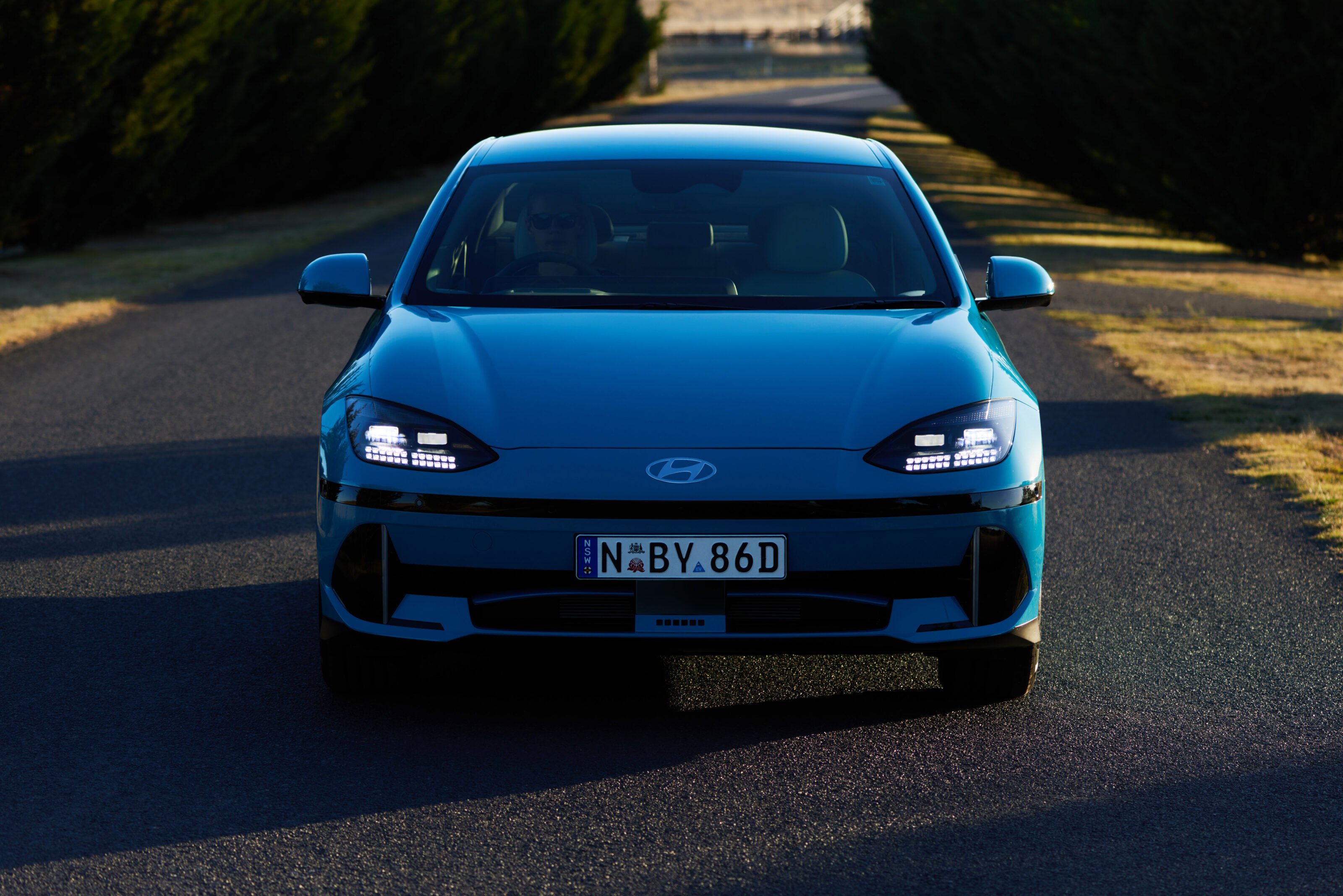
How do rivals compare on value?
By rivals, I’m assuming you mean the Tesla Model 3. And the answer to that question isn’t 100 per cent straightforward.
At the time of writing, a rear-drive Tesla Model 3 retails for $64,300, with a Long Range dual-motor all-wheel drive version priced at $77,300. Tesla prices are notoriously fluid, so it may well be worth double-checking them in your locale.
Therefore, it’s reasonable to assume that the single-motor IONIQ 6 Dynamiq, at $74,000, is nigh-on $10k more expensive than a Model 3. And the Techniq dual monitor IONIQ 6 is just over $6k pricier. So, yes, if you’re absolutely fixated on reducing your spend, buy the Tesla – but I’d implore you never to park your posterior into the ‘mindful cocoon’ that is the IONIQ 6’s interior. Why? Because the moment you do, you start formulating rationalisations for spending the extra.
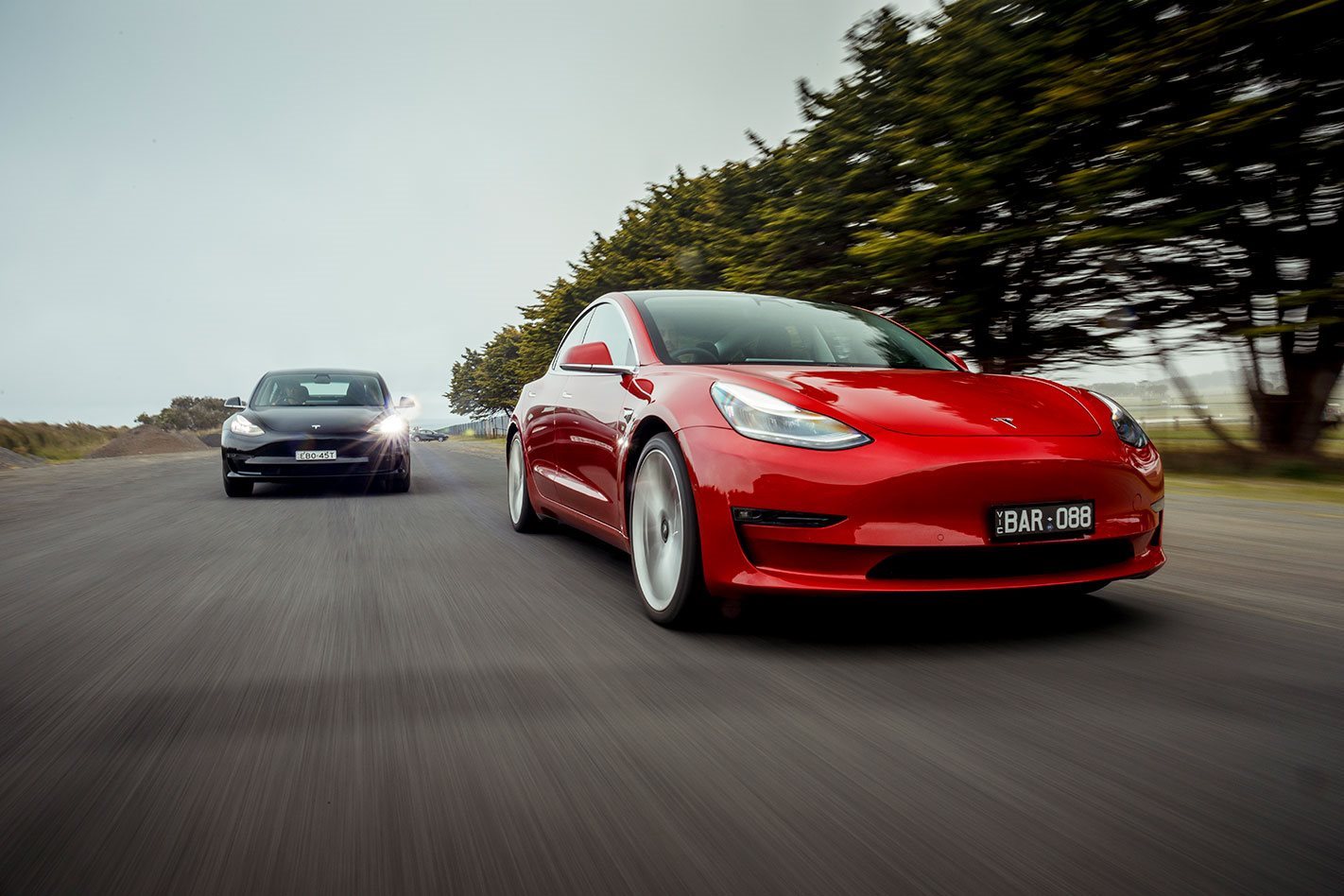
It’s just a far richer experience. Yes, some love the bold, spare austerity of the Model 3’s cabin, and we get that. But as soon as you start delving into what the IONIQ 6 offers, what it actually gives you for the money, it suddenly doesn’t seem bad value at all. Quite the opposite in fact.
If you have decided on the Korean car, perhaps an even gnarlier question is whether the IONIQ 6 offers that much over its sibling, the IONIQ 5.
There will be those – and I’d count myself amongst them – who feel the IONIQ 5 is a far better resolved vehicle from a styling perspective, and that its added utility could well swing the balance for families. It’s also a couple of grand cheaper, model-for-model, but lacks some of the more intriguing equipment items seen in the 6.
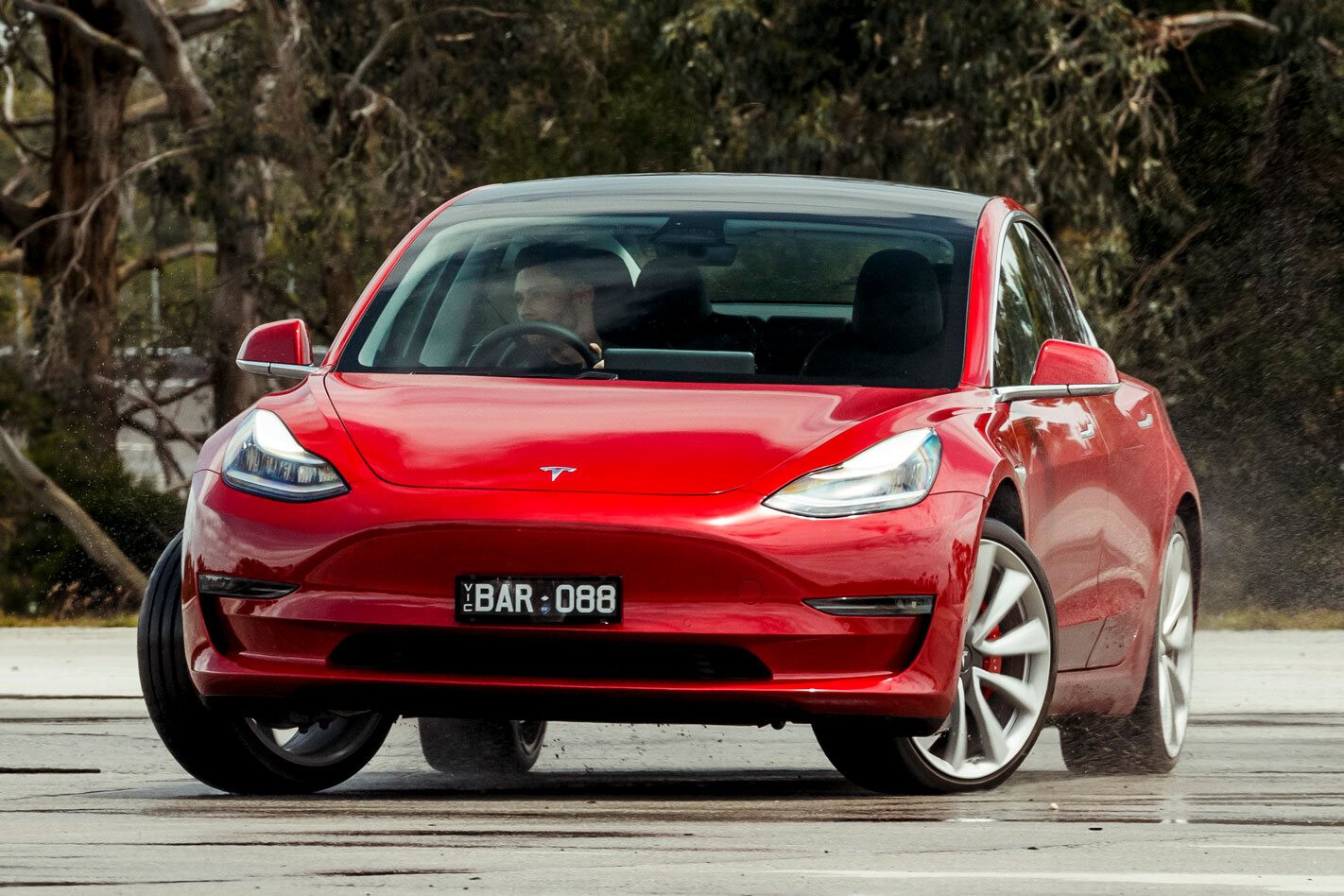
Interior quality, comfort, space and storage
A 2950mm wheelbase is within 4cm of the current Audi A8‘s footprint. In other words, the passenger compartment of the IONIQ 6 is long.
I’m a fairly long 193cm and I’d easily be able to sit in the back of an IONIQ 6 behind my own front seating position. It’s not perfect back there, though. There is a price to pay for that swooping roofline, and it comes in terms of headroom for taller rear-seat occupants.
Anyone much over 185cm will be brushing the headlining and, while there’s no shortage of knee room, the front seats come right down to the floor, so you can’t tuck your toes beneath them. On the plus side, there’s no transmission tunnel, so the central seat isn’t the punish that it is in many cars.

Hyundai makes great play of the ‘relaxation seats’ fitted to the dual-motor models and they’re about 30mm thinner from front-to-back than the more conventional chair on the Dynamiq base model.
Up front, it’s fairly easy to find a comfortable seating position, but the sunroof fitted to the dual-motor versions does rob a couple of centimetres of headroom.
Hyundai has moved the controls that you’d normally find on the front door armrest, such as window switches and door-locking functions, to the centre console. This has then freed up some space on the door cards to create a sweeping, sleek design.
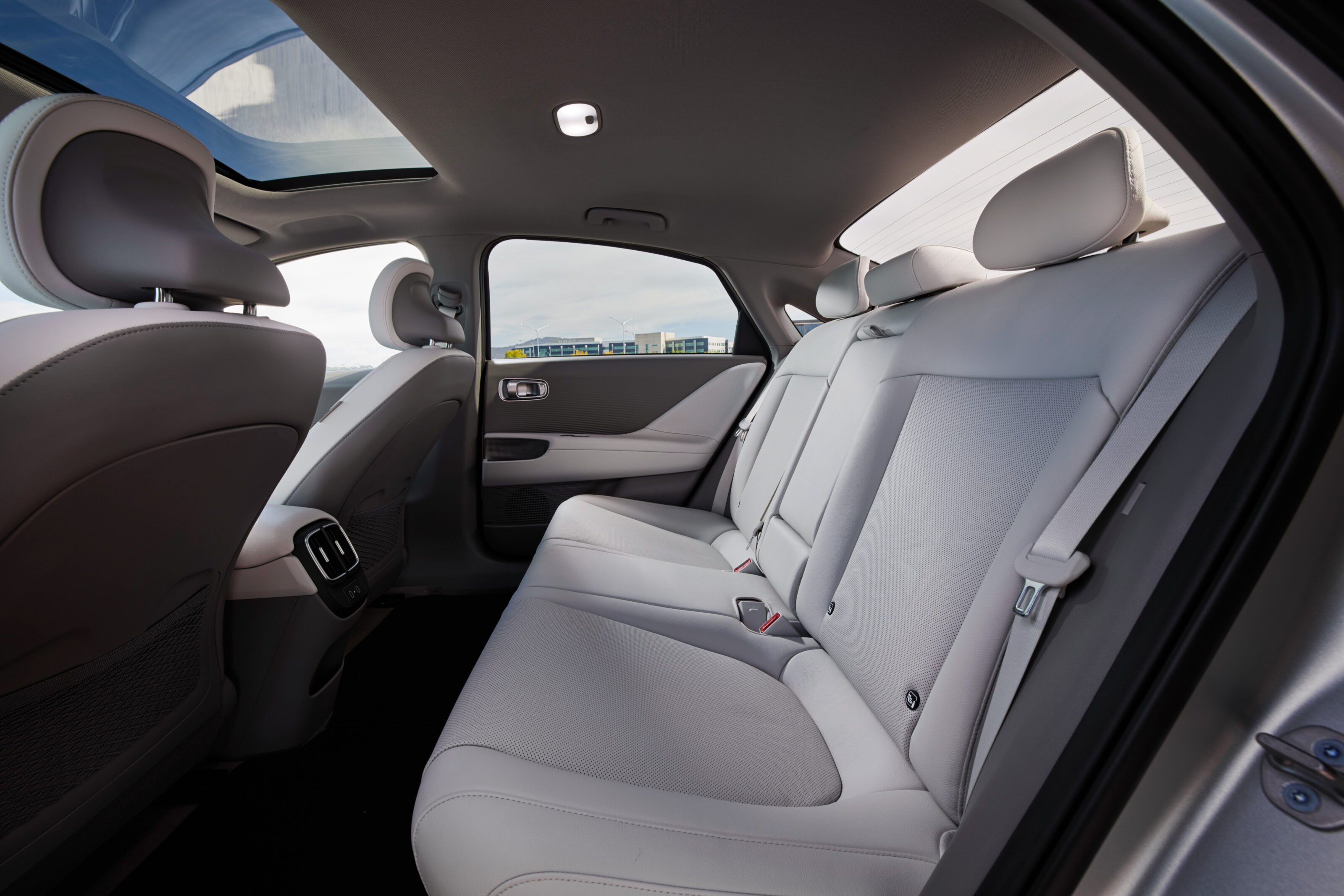
There’s been quite a commitment to using sustainable materials within the cabin, in case that’s why you’re prodding and scratching at the finish of the dash and wondering what’s going on. It’s a bio thermoplastic polyolefin, a byproduct of sugarcane waste.
Likewise, the headlining uses sugarcane extracts while 20 percent of the materials in the carpets is made from recycled fishing nets. Paints for the door cards are created from plant-extracted oils and the leather seats utilise an eco-friendly dyeing process that uses flaxseed extract.
Perceived quality is good, although I’m still yet to be convinced by the column-mounted gear selector. The range-topping Epiq’s electronic mirrors also seem a very complex solution to a bit of a non-problem, and such is their wide angle of view that it made distant, fast-approaching objects fairly difficult to pick.

IONIQ 6 boot space
The boot lid opens electrically to reveal a fairly deep luggage bay that measures 401 litres with 60/40 split rear seats droppable by tabs on the top edge of the boot aperture.
There’s no storage under the boot floor and there’s no spare either, just a mobility kit if you catch a flat. Pop the frunk and what you’ll find depends on which model you’ve chosen.
Without any front motors to complicate things, the entry-level Dynamiq gets a 45L cubby that’s big enough to stow a backpack or a shopping bag. Choose a dual-motor model, however and that space shrinks to just 14.5L.
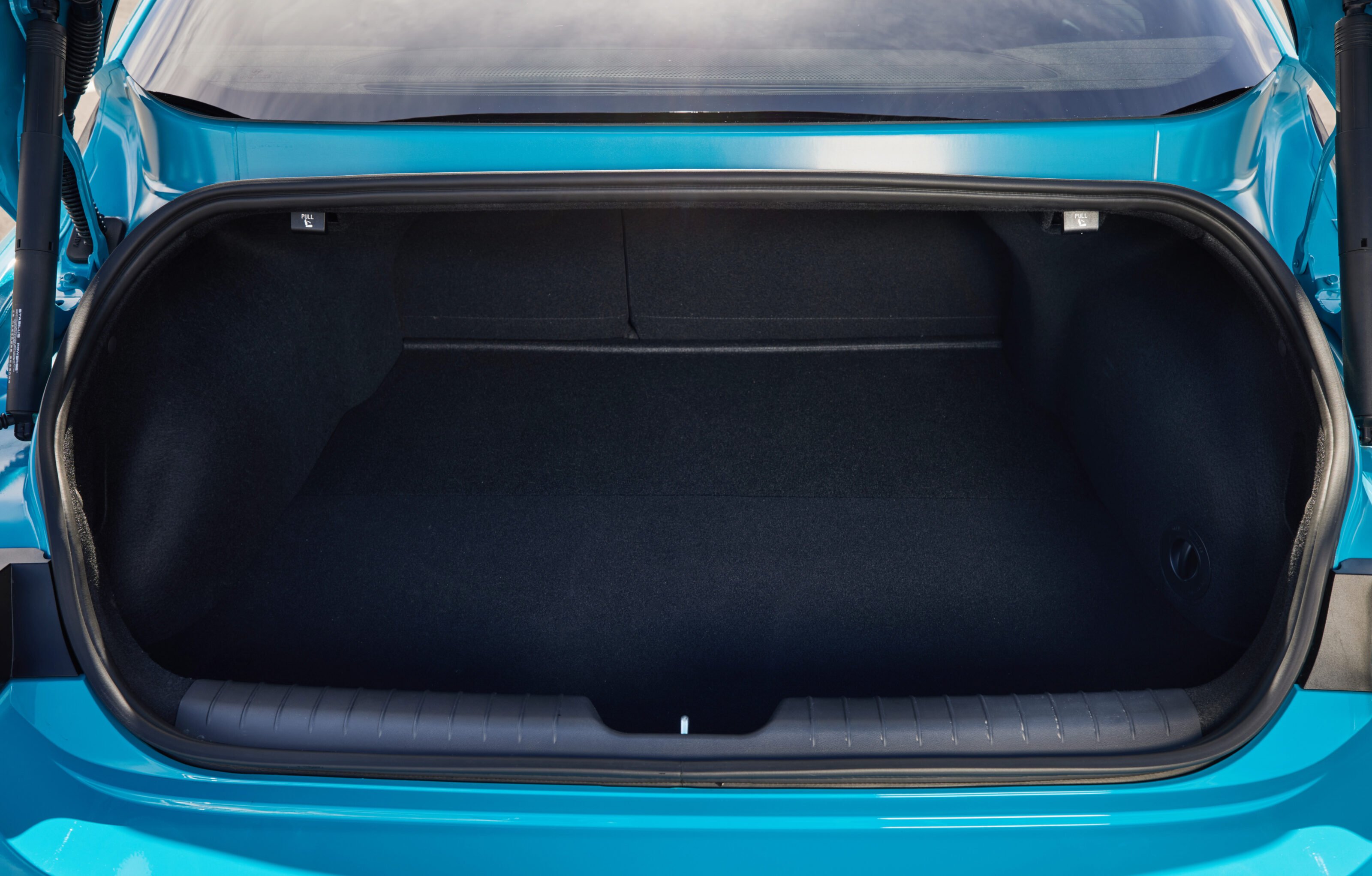
Mini matchup: Boot space
| MODEL | WHEELBASE | BOOT |
|---|---|---|
| Hyundai IONIQ 6 Dynamiq | 2950mm | 401L |
| Tesla Model 3 RWD | 2875mm | 425L |
| Hyundai IONIQ 5 Dynamiq | 3000mm | 527L |

Technology in the cabin
All this tech, but you still need to plug your phone in with a cable for Apple CarPlay or Android Auto.
Come on, Hyundai, you can do better than that. That fairly significant gripe over, let’s move on to the good stuff.
The IONIQ 6 is the first Hyundai production model to get over-the-air updates for its system software. Map updates tend to follow a six-month schedule, but the system can also update and maintain safety-critical functions for braking, performance and driver assist systems without the need to visit a workshop.
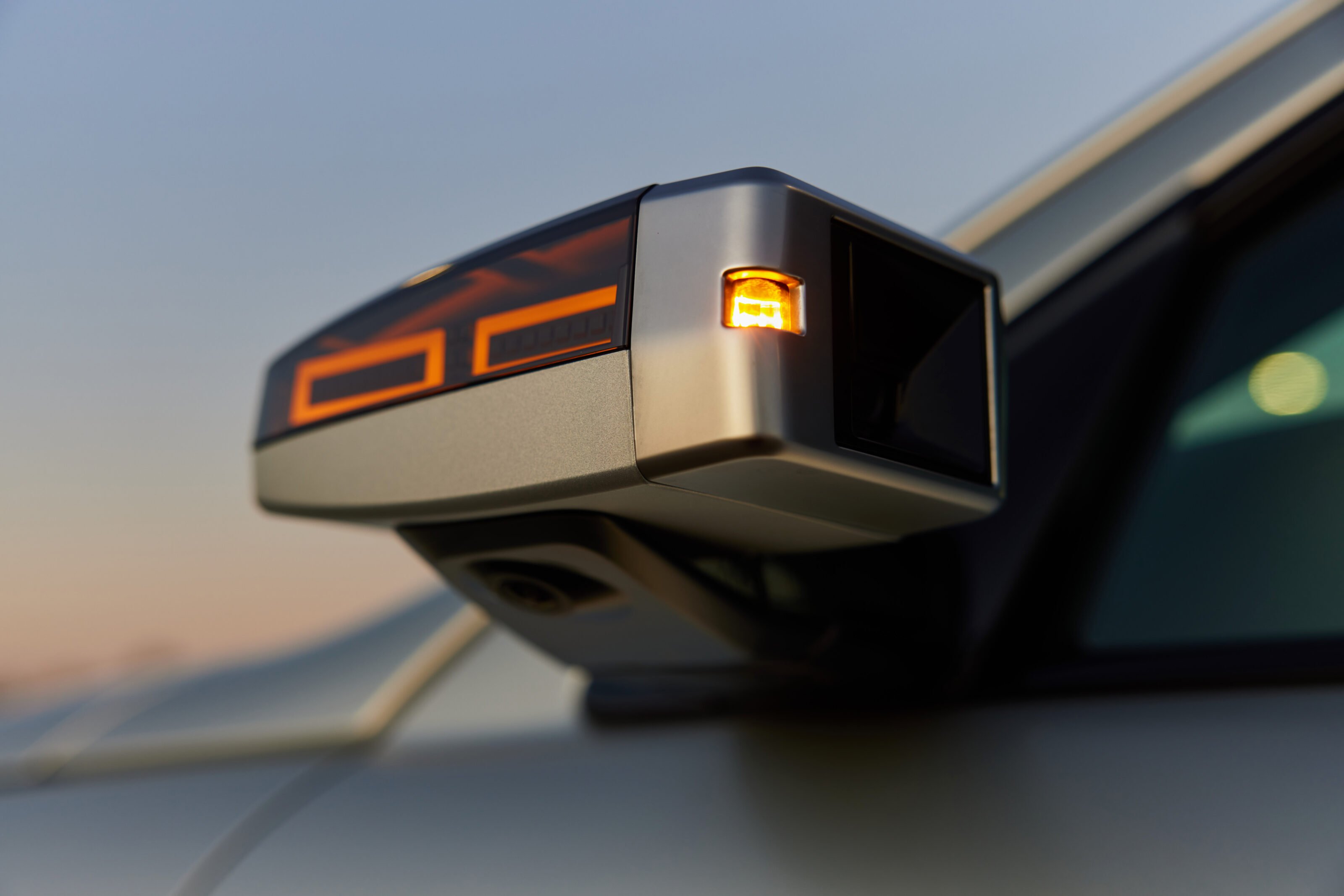
The IONIQ 6 also features as standard a transferable five-year subscription to the Bluelink connected car service suite. The full feature list of Bluelink is vast, so I’ll cover the key functions here.
The scheduling function allows users to set a charging time, and pre-condition the vehicle’s climate control to take advantage of off-peak electricity tariffs. Alarms can be set so that the owner receives notifications when the vehicle is about to complete charging – 30, 20 and/or 10 minutes prior to completion.
Users can remotely monitor the vehicle’s distance to empty and can recommence charging if required. The app allows the owner to find EV charging stations and send the address to the car’s nav. What’s more, there’s a tool which will show on a map the driveable radius with 80 and 100 percent battery charge levels.
Geofencing, valet mode, find my car functionality, vehicle speeds and timeframe management are also included as is vehicle locking and surround view camera control.
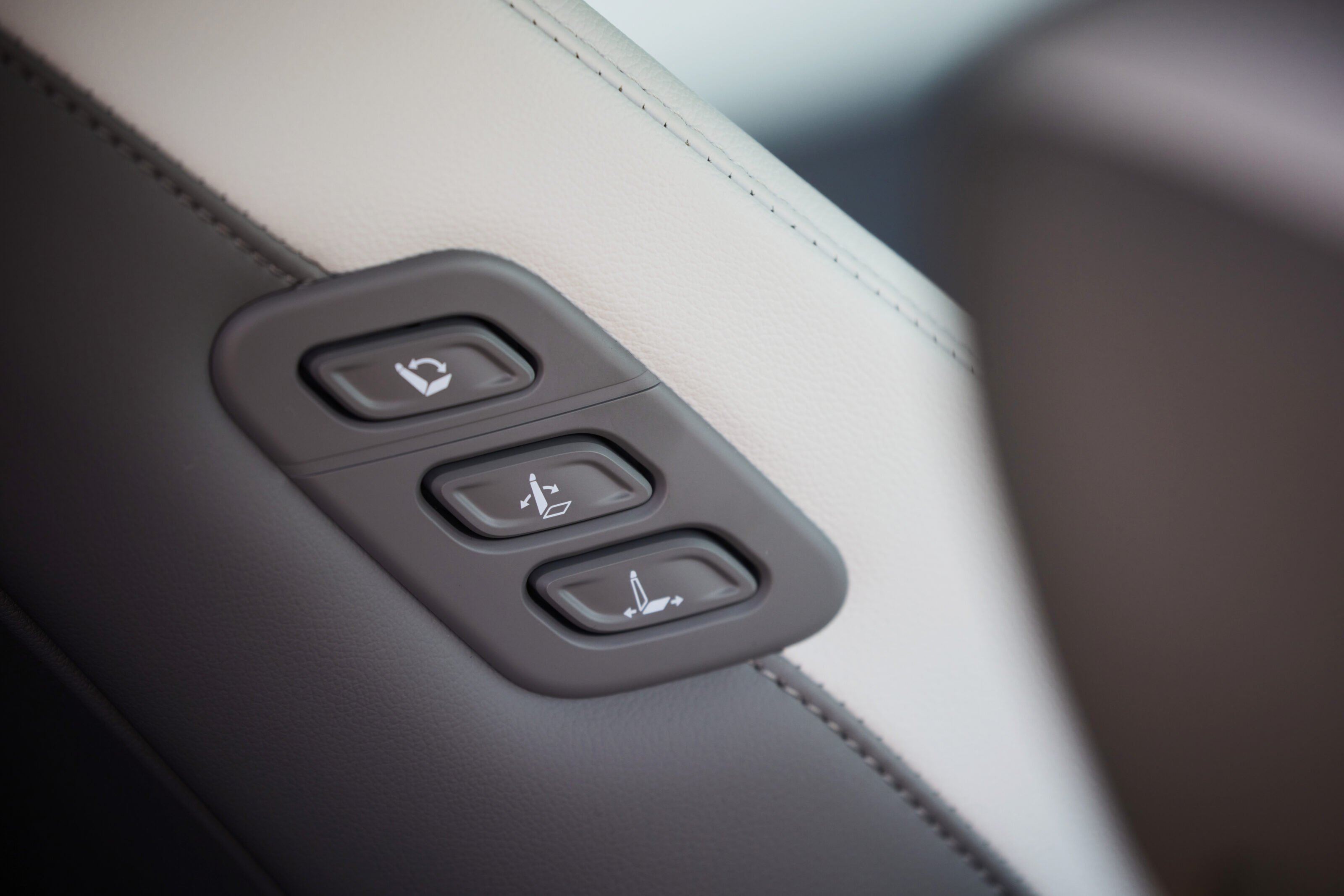
There’s a 15W wireless phone charging pad within easy access under the dash and, unlike many of their kind, will allow the phone to sit happily there with a cable plugged into it. Talking of phones, the dual Bluetooth functionality of the IONIQ 6 allows for one phone to be used to handle music streaming, with another used for calls.
Should you feel a little adventurous, the IONIQ 6 features vehicle-to-load functionality. The internal port is located beneath the rear seats and features a 250V/15A, or 3.6kW, output and is ideal for charging laptops and such like.
Alternatively, a V2L adapter can be purchased and plugged into the main exterior charging port which allows things like e-bikes, scooters or camping equipment to be powered from the car. There’s even a Vehicle-To-Vehicle (V2V) function via a portable emergency charging cable that could help a friend out of a spot if they’re critical on charge.
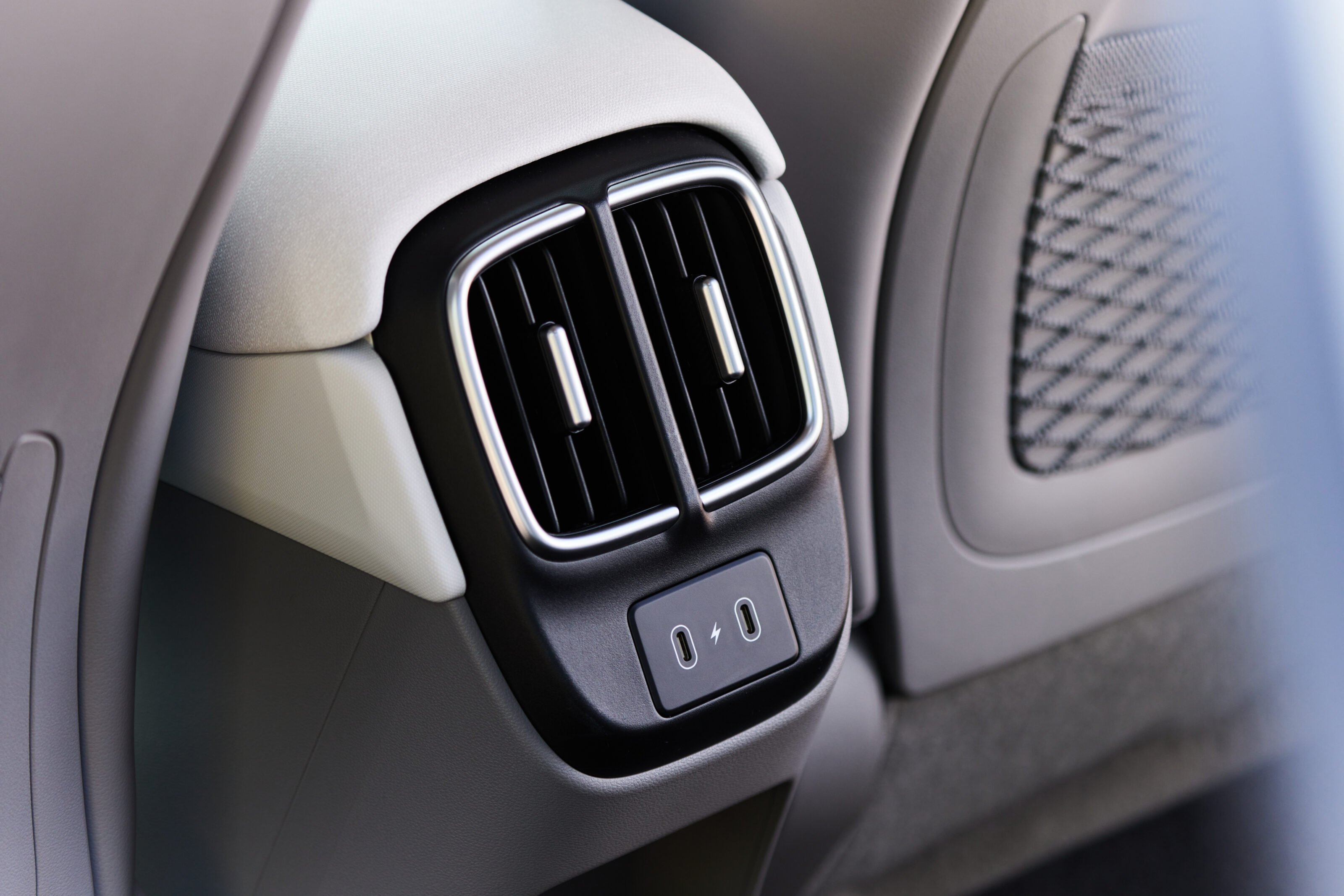
The dual 12.3-inch landscape-oriented screens sit edge to edge and provide a wealth of information, the native system is quick, responsive and fairly easy to navigate. Whereas some manufacturers are happy to cede this territory to Google or Apple, Hyundai seems to have quite the opposite philosophy. It appears that the Koreans have tried to build so much functionality into the proprietary ecosystem that they hope you’ll be tempted to ditch the smartphone mirroring.
The IONIQ 6 comes as standard with a multi-configurable interior ambient lighting setup with a number of themes, including a speed-sensitive setting where the lighting becomes more intense the faster the car travels. There’s also a curious array of pinhole LEDs on the steering wheel boss that can communicate function changes such as a switch in drive modes.
Finally, there’s an exemplary head-up display as standard in all IONIQ 6 models. It’s crisp, easily configurable and doesn’t overload the driver with extraneous information.
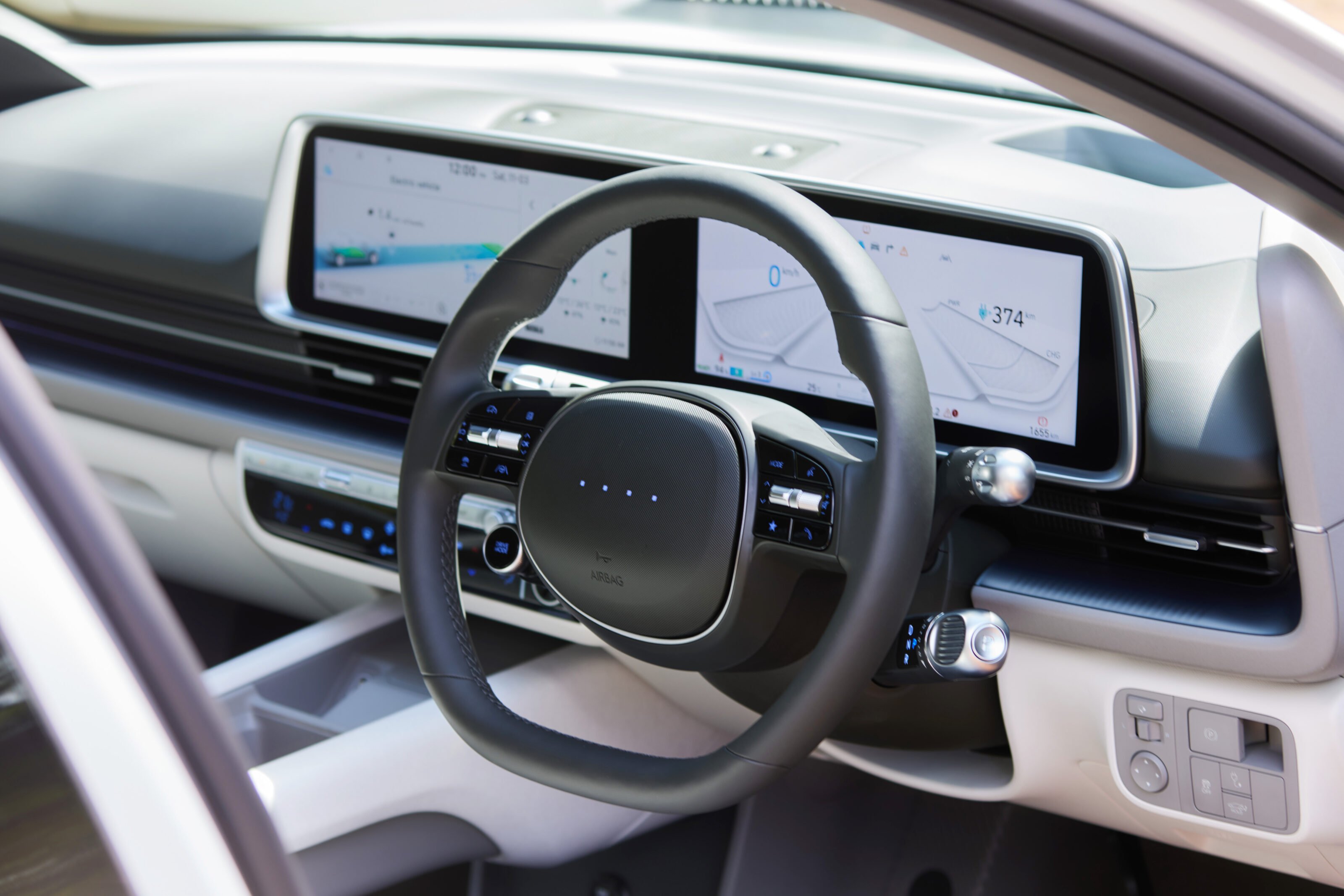
What is it like to drive?
The good news? That nervy ride quality that afflicted early IONIQ 5 imports has largely been excised.
To be fair to Hyundai, it’s largely been excised on the IONIQ 5 too, thanks to the belated fitment of the Smart Frequency Dampers that are fitted as standard to the IONIQ 6.
As such, the ride of the IONIQ 6 is relatively plush. It’s still not what you’d call pillowy, jolting a little over shallow road imperfections, but there’s not that constant pitter-patter in the secondary ride that blights many EVs. Ever wondered why that is? It’s due to the fact that EVs are significantly heavier than ICE vehicles of the same class, and therefore have a large amount of energy moving up and down due to their weight.
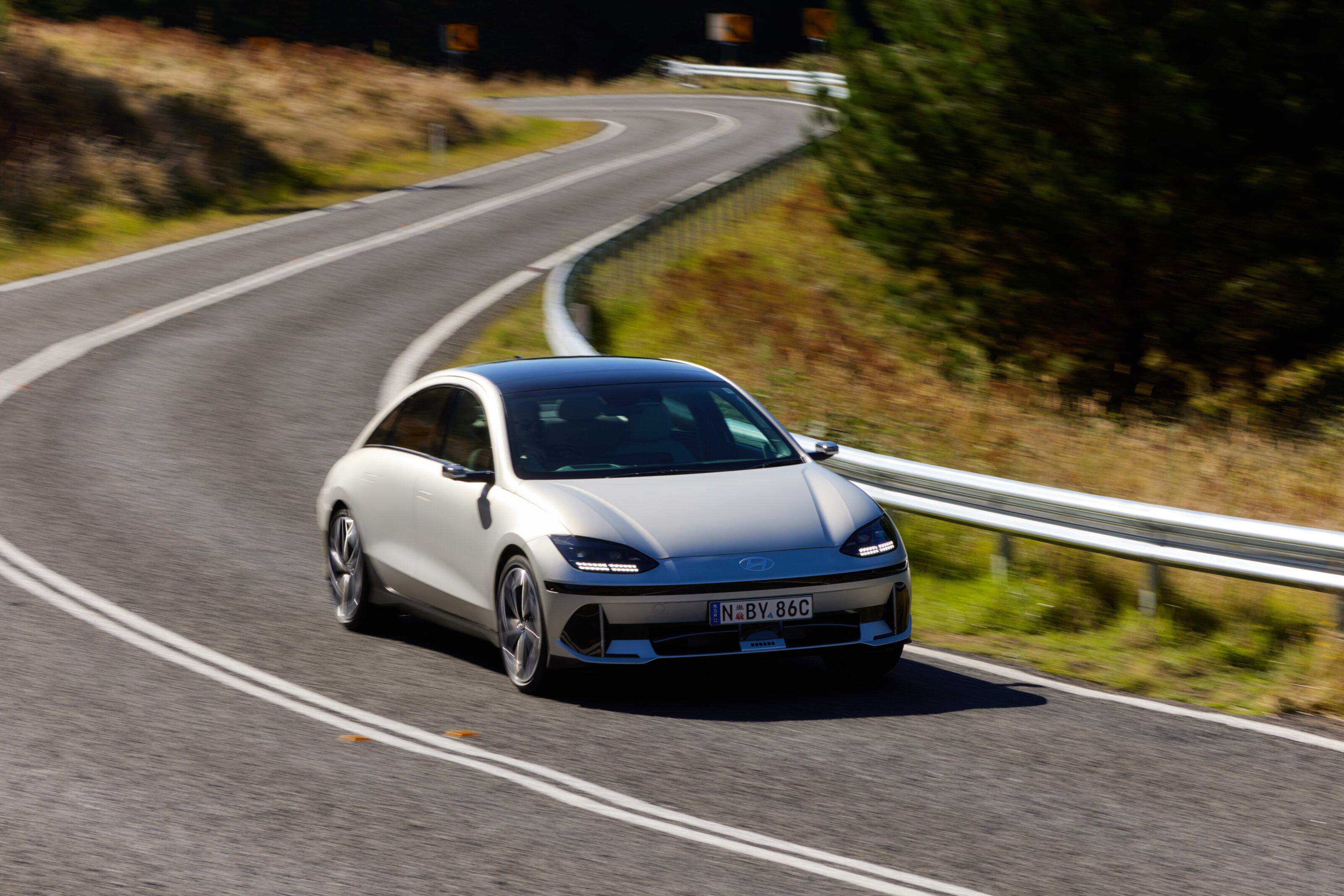
In the past, conventional hydraulic shock absorbers have encountered limitations in controlling this movement – what chassis engineers call ‘heave’. In optimising the suspension to cope with the low frequency rise and fall, the net effect is that the dampers are not optimised to handle small bumps and vibrations from the road surface.
The IONIQ 6’s dampers feature both a frequency-sensitive valve that complements a fixed valve, with the result that they adequately handle both high-frequency jitters and low-frequency body undulations. The fitment of clever vertical hydro bushings in the IONIQ 6’s lower control arms – a first for Hyundai – also helps add a sheen of polish to the ride quality.
The steering is a fairly mute partner. It’s accurate and well-geared but doesn’t offer much in the way of communication. Switching the car into Sport mode adds weight without much else in the way of benefit. Hyundai engineered a bearing into the IONIQ 6’s steering column to help reduce vibration and it’s undeniably effective. Maybe a little too effective.
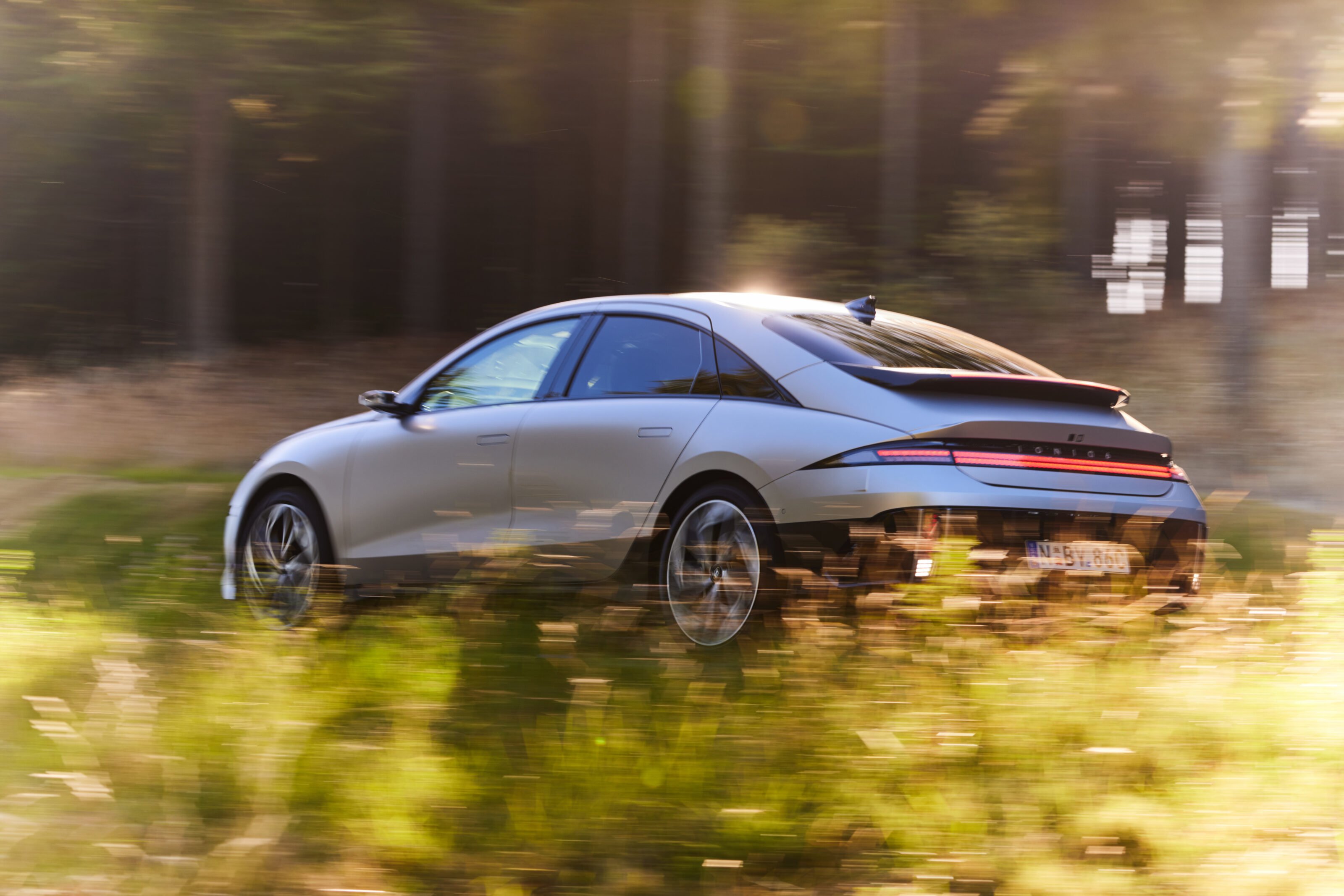
The IONIQ 6 defaults to lane-keep assist on, corrupting the steering feel with unhelpful nudges and pulls through the rack-mounted electric motor. I can’t stress this enough, but if a driver then switches into Sport mode, it’s overwhelmingly likely that lane-keep is not required. The car should switch it off but it doesn’t and trying to prevent it re-engaging is harder work than it needs to be.
Likewise, another default-on driving ‘assist’ is speed limit warning. This could be quite helpful in certain scenarios, but it’s too keen to interrupt, distracting the driver all too often. Compounding that issue is its propensity to latch onto speed limits that are incorrect.
At one point on the Hume Highway, it seemed certain that I was exceeding what it thought was a 40km/h speed limit and started chiming incessantly. Especially if you’re mirroring a phone, delving through the native menu structure to switch it off isn’t at all straightforward.
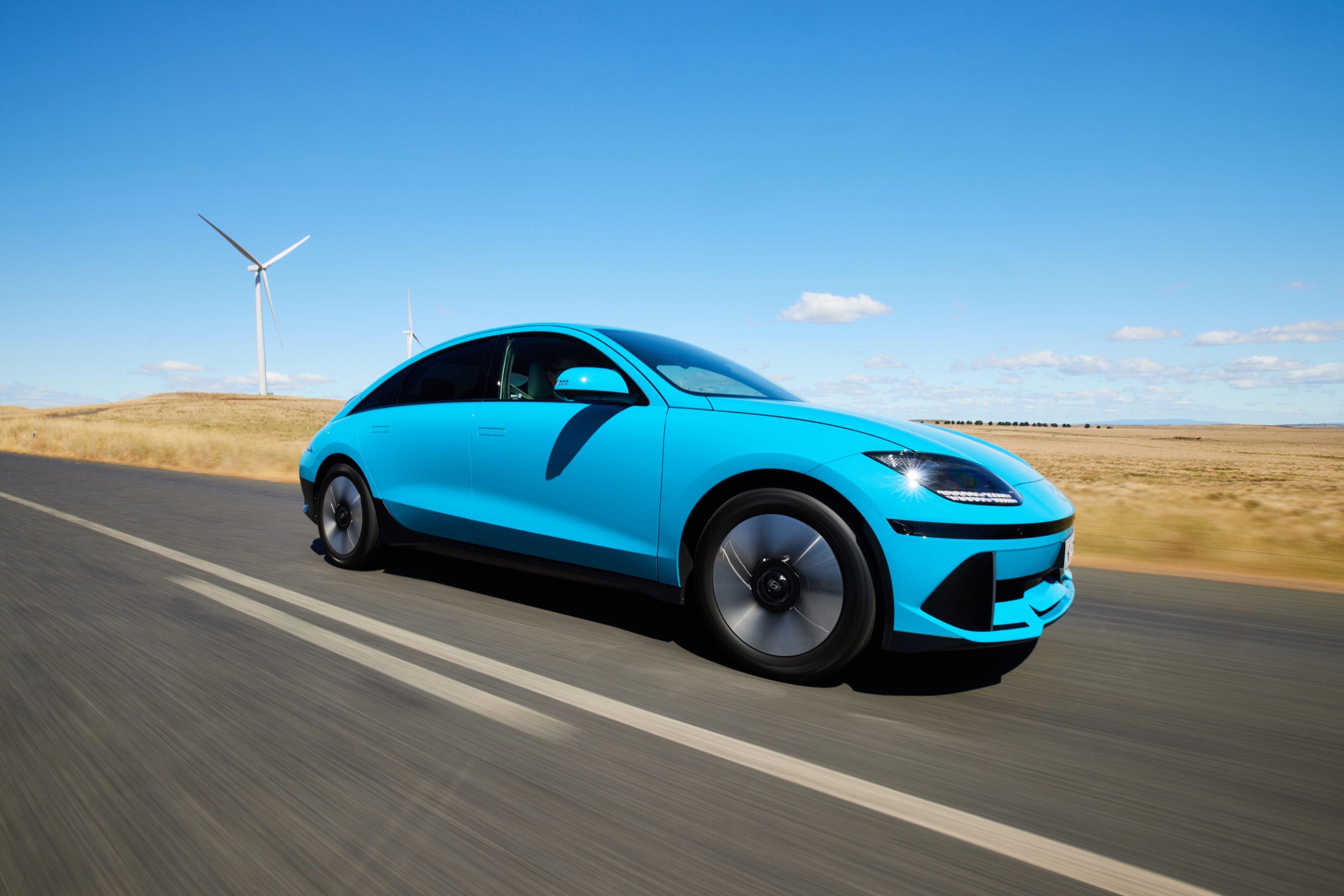
Fortunately there’s ample measure of recompense in the way the IONIQ 6 drives. It disguises its weight well, with dual motor cars tipping the scales at 2078kg. Like most cars of its type, you only become aware of that two-tonne heft when the car moves vertically over large bumps.
By and large, the IONIQ 6 manages its dynamic compromises very well. Leaving aside the taciturn steering, the dual-motor models I tested corners tenaciously and the traction and stability control systems are excellent, only doling out a precise measure of torque when it’s clear the vehicle can accept it. The chassis is a good deal more rigid than that of the IONIQ 5, which has helped the engineers isolate and manage the specific forces that the suspension system has to deal with.
Overall refinement is a notable standout, with little in the way of wind, tyre or suspension noise. If anything the models with conventional mirrors are a little quieter at speed than the Epiq with its boxy camera housings.

The IONIQ 6 further isolates the passenger cell from noise, vibration and harshness from the rear end by using a dynamic damper mounted in the rear cross member to help quell resonance vibration. Even the carpets are two-piece affairs that help reduce resonance.
The brakes are decent, and there’s always the option to augment the friction brakes with electric re-gen. The paddles behind the steering wheel can cycle from off through four subsequent modes to a full one-pedal setting where the IONIQ 6 will come to a standstill with no accelerator input. At the other extreme, it’ll coast like a Taycan when the re-gen is switched off.
Unlike a Taycan, there’s no two-speed transmission, but it doesn’t seem a significant miss. The dual-motor cars will accelerate cleanly from 0-100km/h in 5.1 seconds, which compares to 4.6 seconds for a Tesla Model 3 Long Range. The rear-drive Dynamiq model takes 7.4 seconds to break 100km/h which is some way off the Model 3 RWD’s 6.1 second sprint.
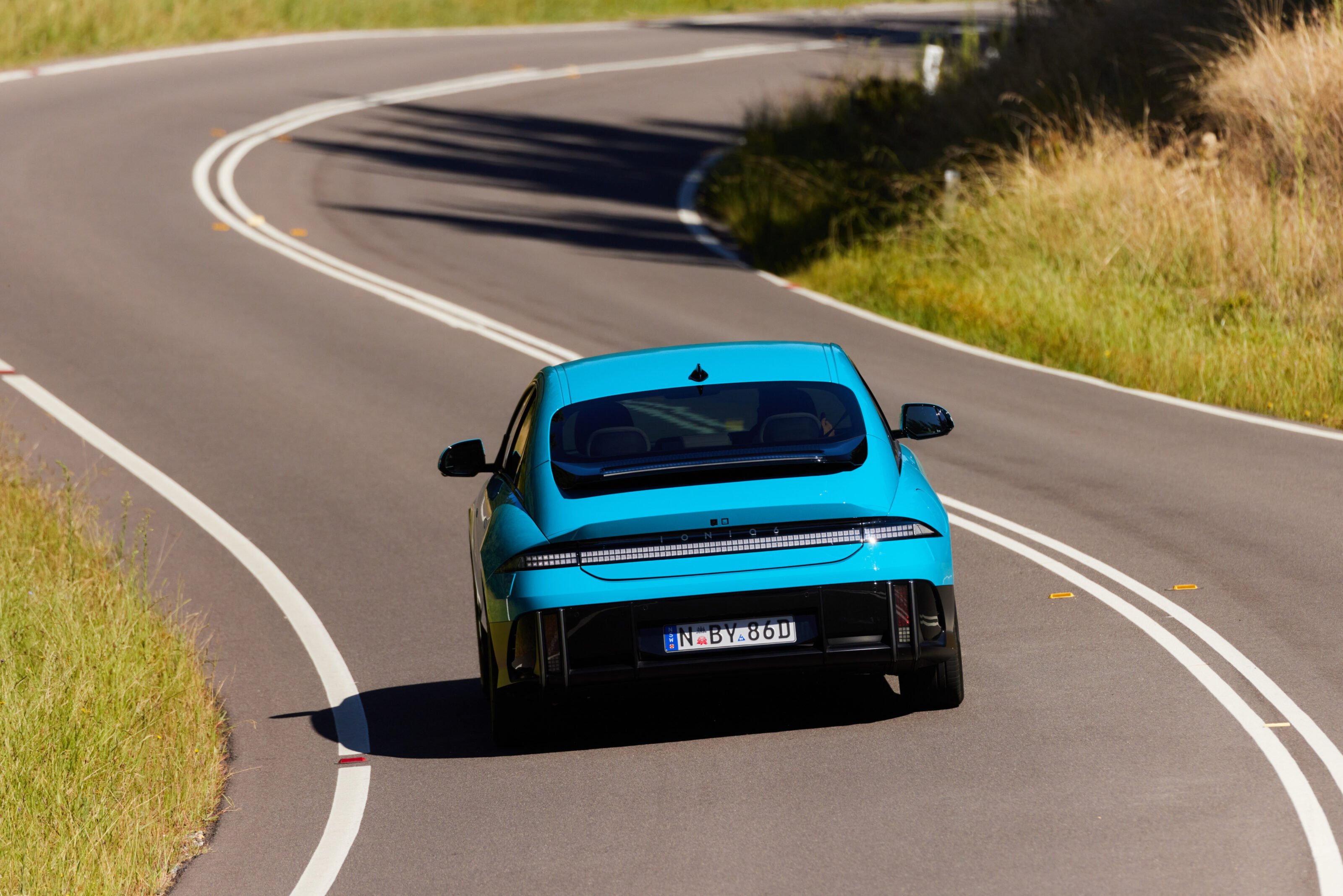
Drive does include the usual Normal, Sport and Eco, and there’s also a Snow setting and a Custom mode which allows you to tailor steering, throttle and driveline settings but not suspension. That’s passive on all IONIQ 6 models.
The adaptive cruise is also very polished, modifying speed smoothly. It can be a little slow to start re-accelerating once a vehicle has cleared your lane ahead and, conversely, will accelerate reasonably quickly if a car passes you and you indicate out behind it. By and large it’s a decent system though.
The Hyundai feels a significantly smoother and more refined vehicle than the Tesla, but we may well have to wait for an N version of the IONIQ 6 to see the sort of genuinely concussive pace delivered by a Model 3 Performance.
Should you wish to tow anything – and we can think of many better candidates than an electric sedan to do so – then an accessory tow bar is available and the braked towing capacity is 1600kg.
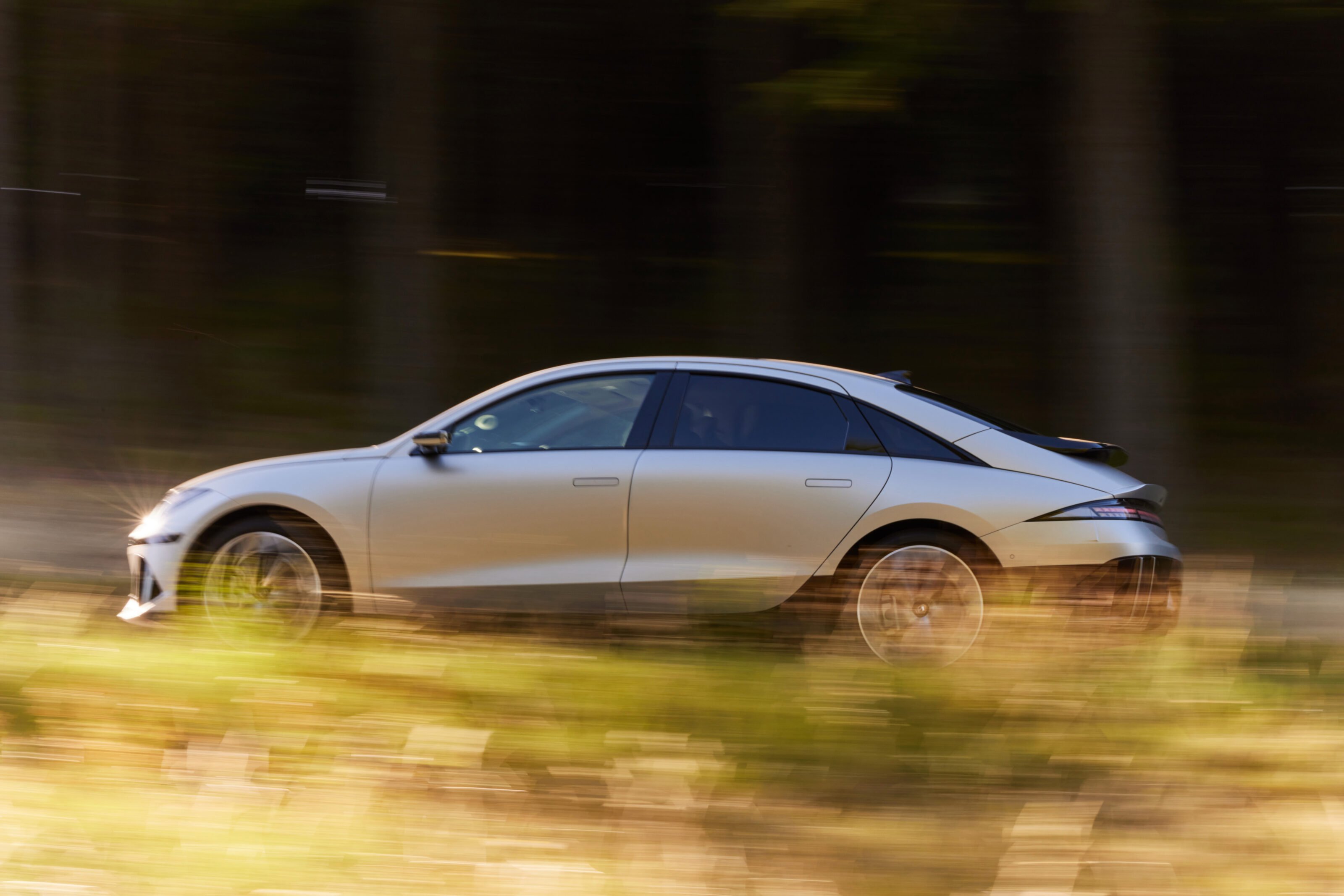
How much energy does it use?
That slippery shape certainly helps economy and the range is quoted at 614km for the rear-drive car and 519km for the dual-motor models.
Hyundai plays a bit of an ace card with its 800V EV architecture which means that you’ll be able to charge the 77.4kWh lithium-ion polymer battery from 10-80 percent in just 18 minutes on an ultra-fast 350kW charger. If you’re stuck with a garden-variety 50kW DC charging station, that time blows out to 73 minutes.
A typical AC home or work wallbox will charge from 10 to 100 percent in 11h 45m on 7kW single-phase, or 7h 10m on 11kW three-phase. Plug it straight into a 240V AC power outlet and a full charge will detain you for 34h 20m. Not recommended.
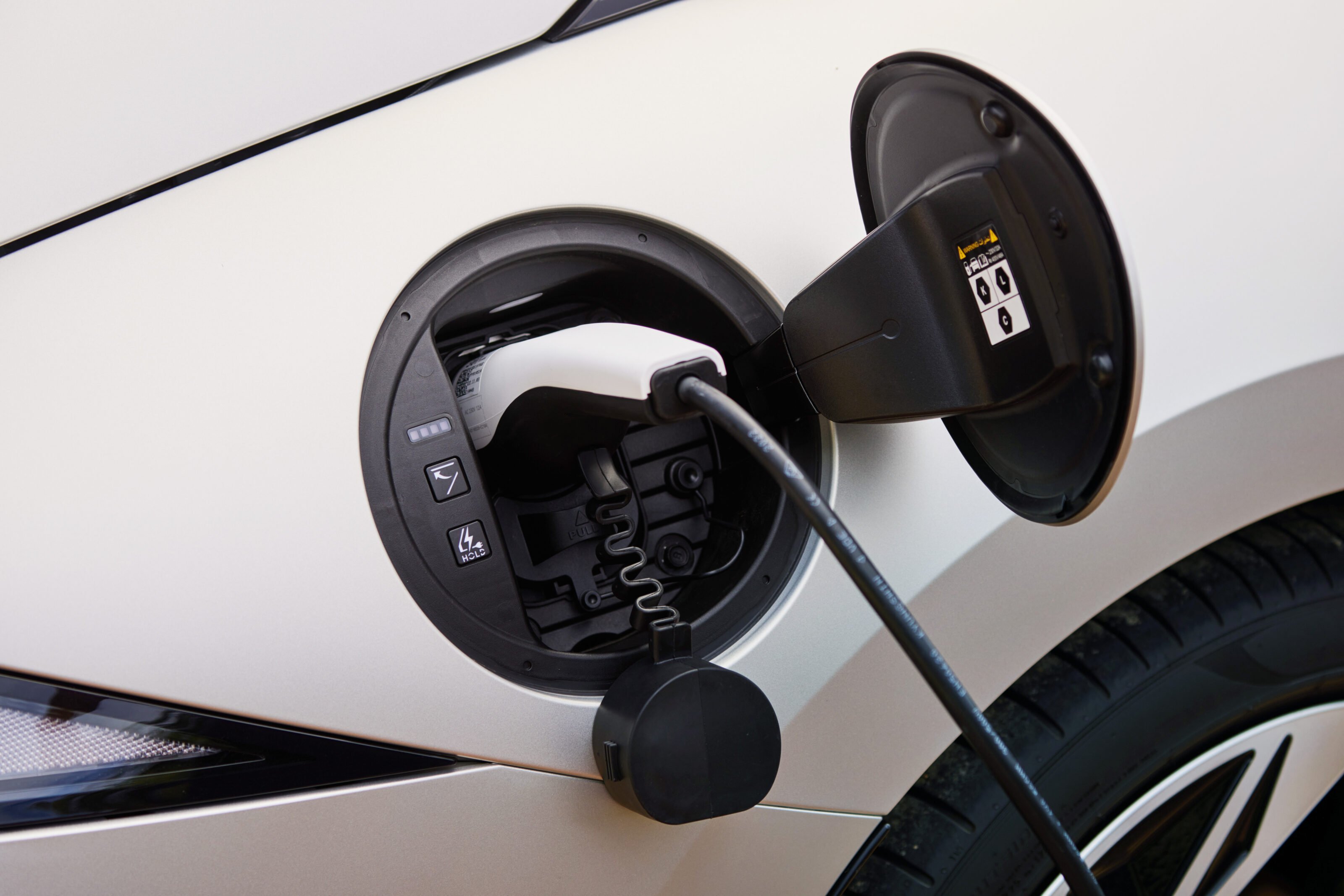
The long drive back from the launch venue on fast, open roads saw an average consumption of 15.8Wh/100km in the Epiq dual-motor model. That’s helped by active air flaps at the front of the car that can open to aid cooling and then motor closed to help aero.
The range calculator seemed very accurate, updating itself as you switch between drive modes, alter the air conditioning settings or change your driving style.
A schematic on the dash shows how the vehicle apportions drive, and for most of the journey, the onboard Disconnector Actuator System had clearly told the 74kW front motor to take a break, improving efficiency by sending 100 percent of torque to the 165kW rear motor.
Mini matchup: Range battle
| MODEL | DRIVE | RANGE CLAIM (WLTP) |
|---|---|---|
| IONIQ 6 Dynamiq | RWD | 614km |
| IONIQ 6 Techniq | AWD | 519km |
| Model 3u00a0 | RWD | 491km |
| Model 3 Long Range | AWD | 602km |
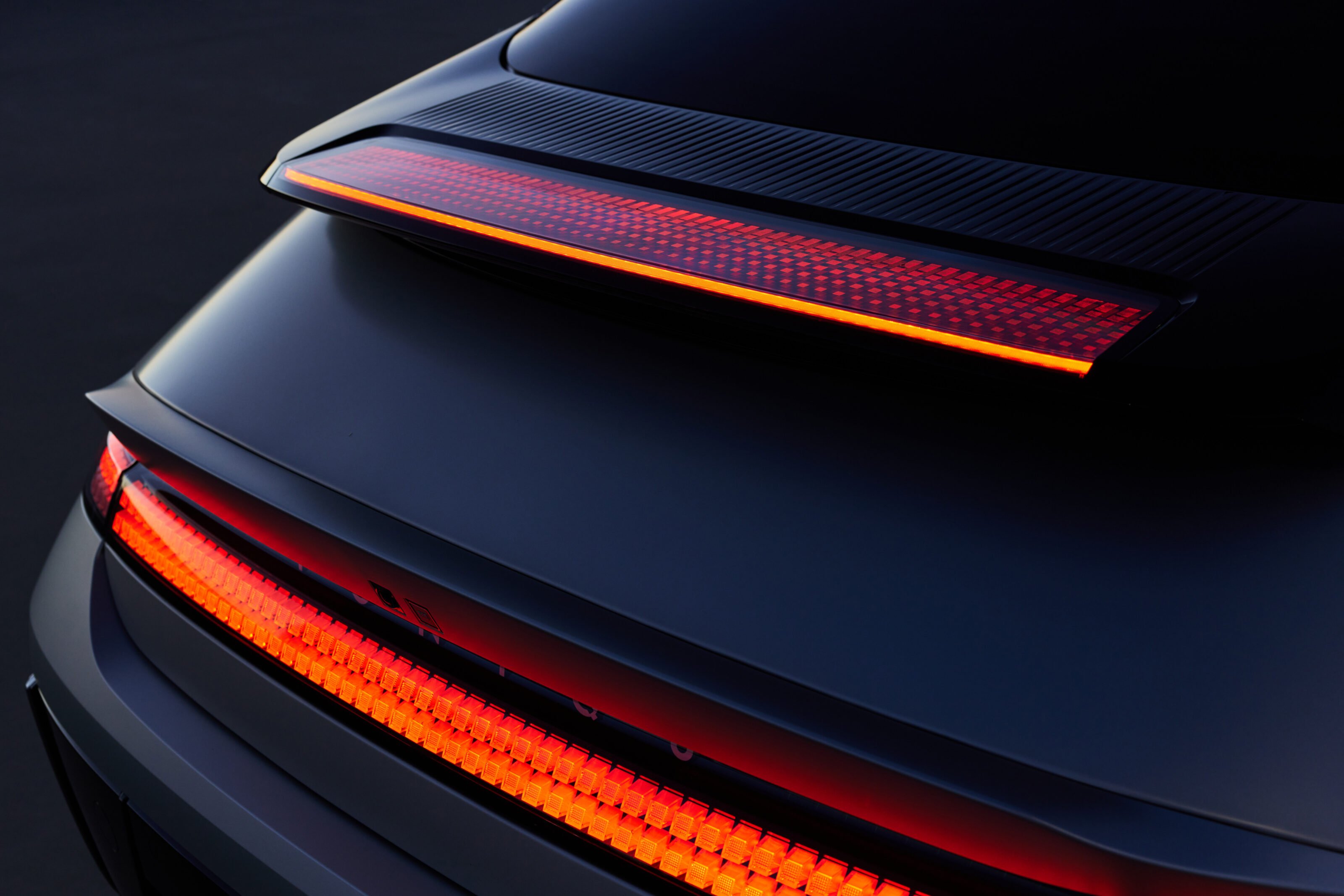
How safe is it?
Glad you asked. The short answer? Very. The IONIQ 6 – every IONIQ 6 – features a jaw-droppingly comprehensive safety suite.
So much so that it’s hard to know exactly where to start when describing the full capability of Hyundai’s SmartSense tech. Here are twenty interesting nuggets just to clue you in to how comprehensive it really is.
- 1: Forward Collision Avoidance (FCA): This monitors vehicles, pedestrians and cyclists that are approaching from ahead. It sounds a chime and a warning in the instrument cluster which, most of the time, will be adequate, but it can then use the front radar and cameras to slow the vehicle from speeds of up to 200km/h. So if a vehicle has wandered into your lane, the IONIQ 6 will brake to a standstill if required.
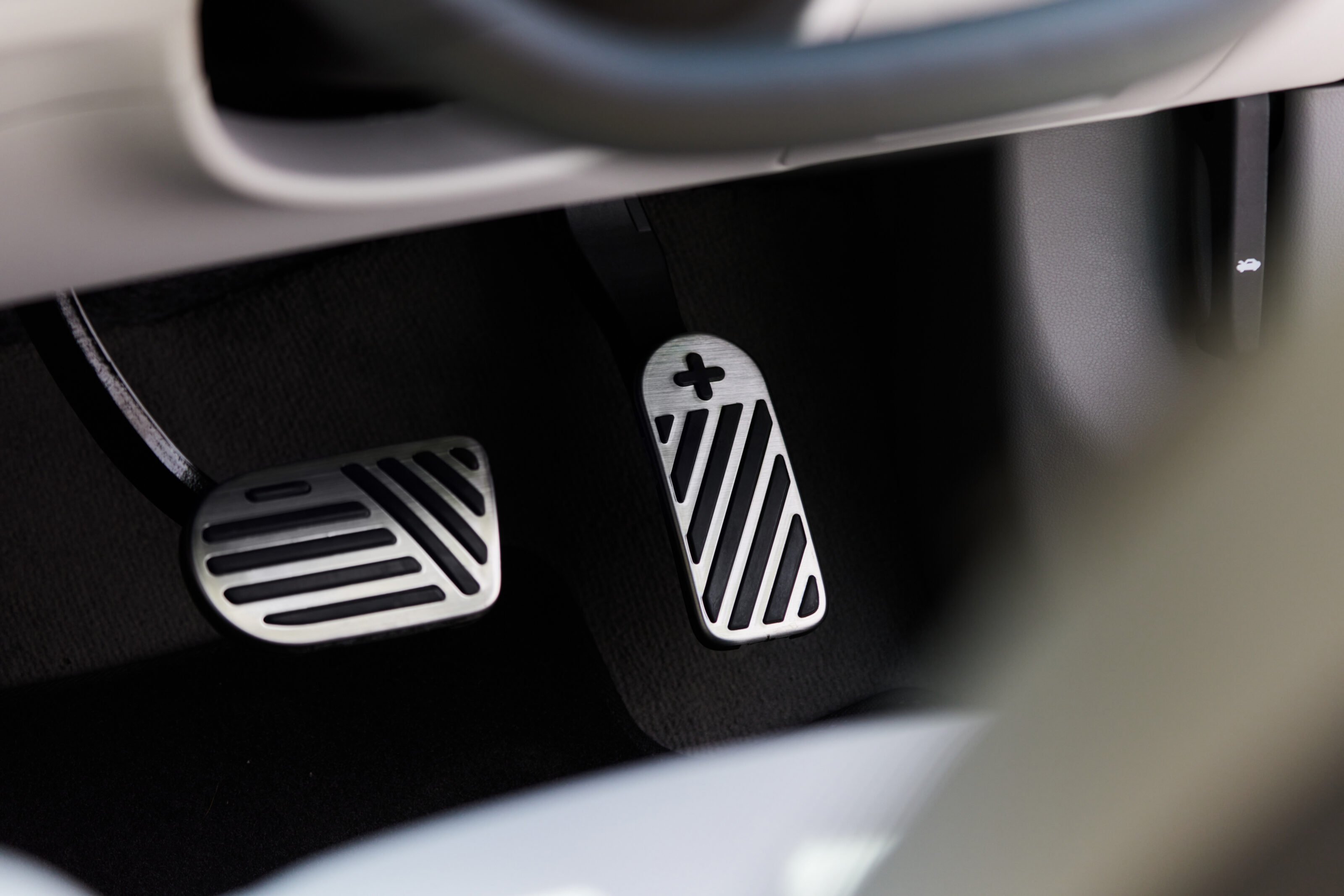
- 2. Junction Turning (FCA-JT): Sit your car in a right-hand lane with the indicator on and FCA-JT kicks in. This scans for oncoming vehicles driving between 30 and 70km/h and will attempt to prevent you pulling into their path if it decides a collision is imminent.
- 3. Junction Crossing (FCA-JC): If you’re at a four-way box junction, FCA-JC will use radars to detect vehicles approaching from left and right and will apply emergency braking if it thinks you’re about to pull out in front of it.
- 4. Lane-Change Oncoming (FCA-LO): This function provides steering assistance to help avoid an oncoming vehicle in an adjacent lane and is active from 45 to 140km/h.
- 5. Lane-Change Side (FCA LS): If the IONIQ 6 thinks you’re in danger of colliding with a vehicle in an adjacent lane on a multi-lane road, FCA-LS will provide steering avoidance.

- 6. Evasive Steering Assist (ESA): The final function in the forward collision suite avoidance is ESA which looks to detect pedestrians or cyclists ahead in your lane which you may not have seen. As a last resort, ESA will steer the vehicle to avoid if there is space within the driving lane.
- 7. Parallel Exit: This will apply the brakes sharply if the system detects that you’re exiting a parallel parking place and haven’t detected a vehicle in your blind spot.
- 8. Safe Exit Warning (SEW): This system detects traffic in the blind spot and sounds a warning if it believes that the IONIQ 6’s doors are about to be opened into the passing vehicle/cyclist/pedestrian’s path.
- 9. Rear Cross Traffic Collision Avoidance Assist (RCCA): If you’re a lazy driver like me and never reverse into a parking spot, this one’s really helpful in Coles car park. It’ll warn you if you’re just about to reverse into something’s path.
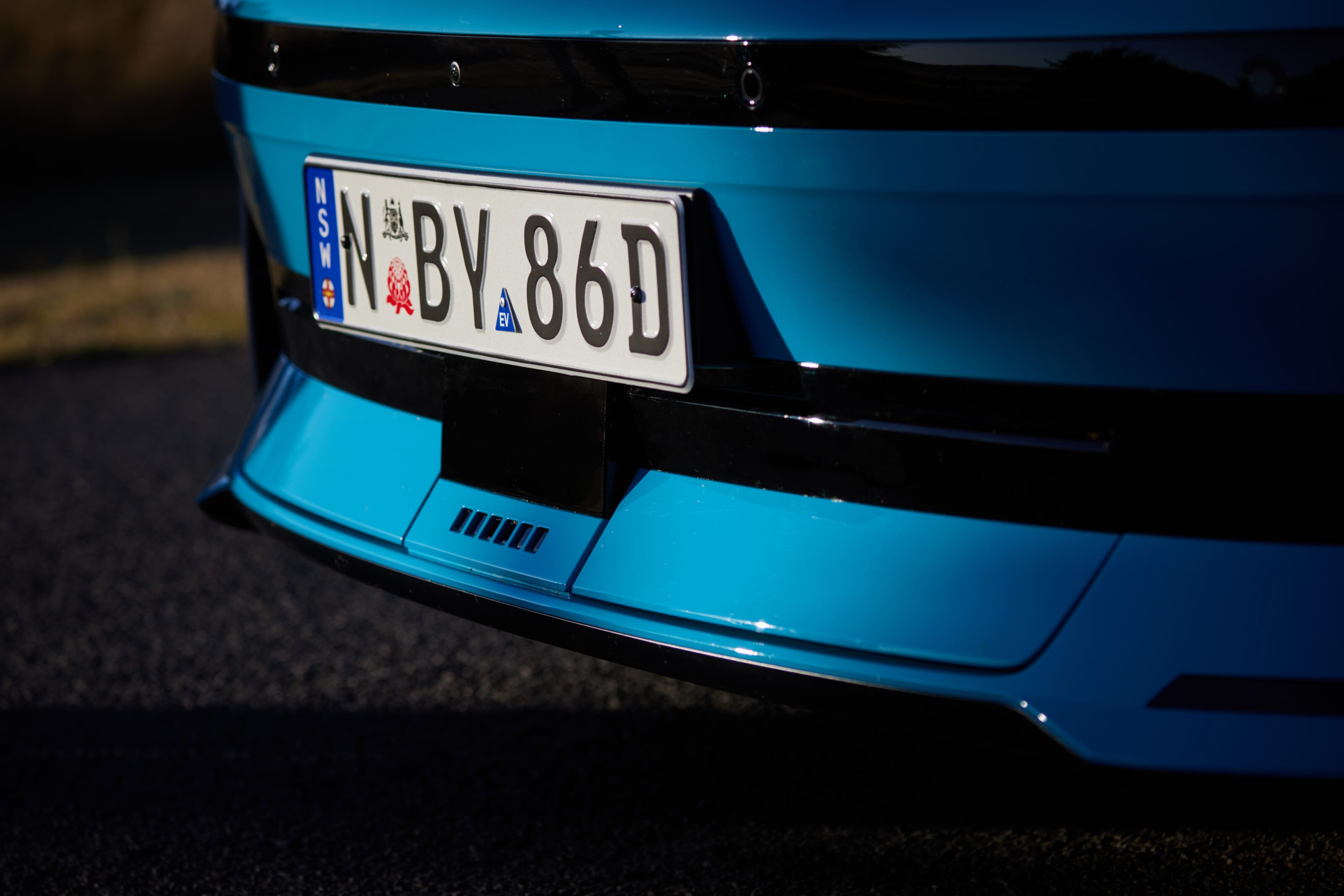
- 10. Blind-Spot View Monitor (BVM): Flick the indicators on and this system uses cameras to project an image onto the 12.3-inch display. Handy if you’re about to effect a left turn and take a cyclist with you.
- 11. Driver Attention Warning (DAW): This monitors your position in the lane, steering inputs, braking inputs and time since last break to assess whether you’re a bit below par.
- 12. Leading Vehicle Departure Alert: this sounds a chime if the vehicle ahead that’s stopped in traffic has pulled away and you haven’t reacted to it.
- 13. Remote Smart Parking Assist (RSPA): Yep, the IONIQ 6 does automated parking and can be summoned using its key.
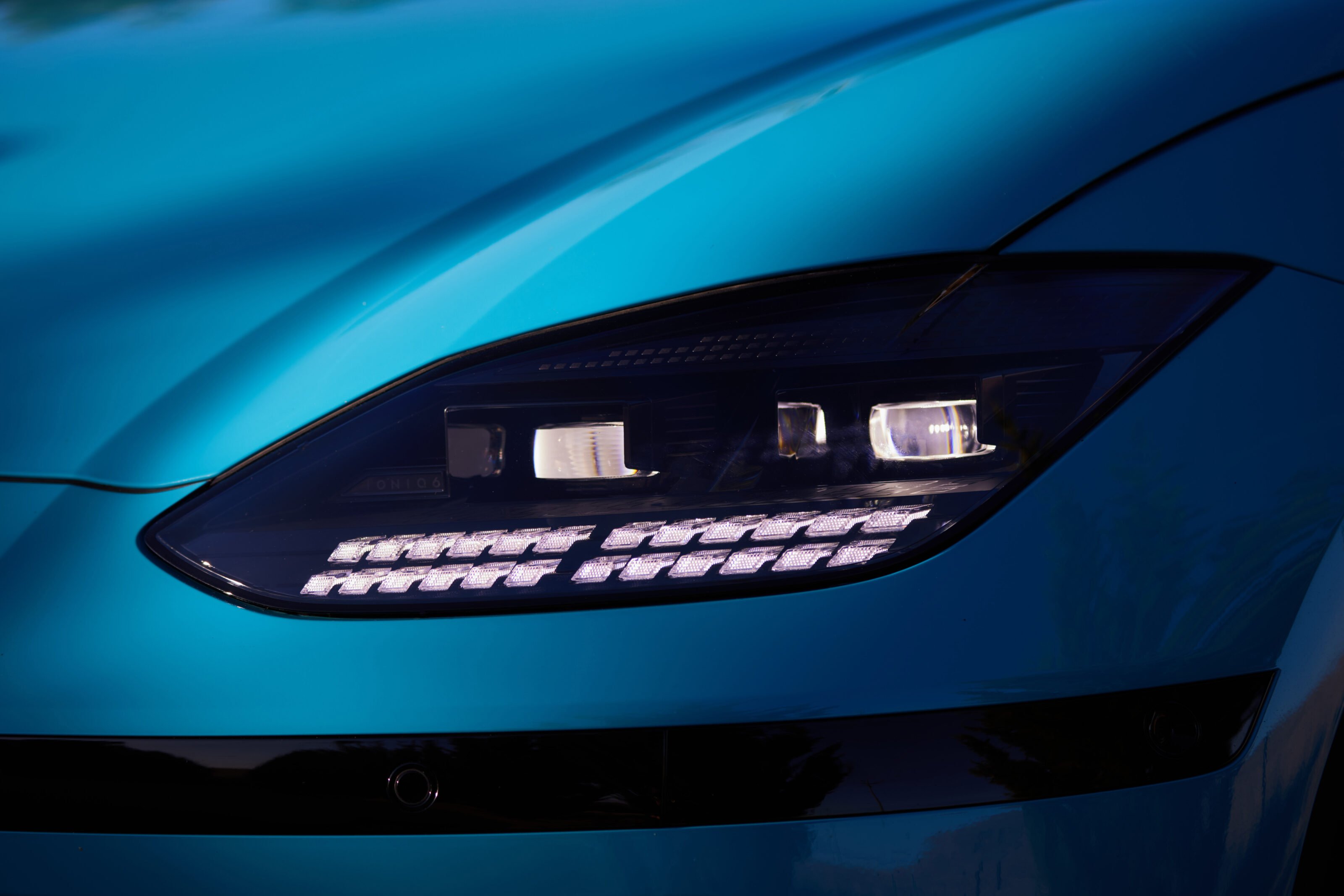
- 14. Intelligent Speed Limit Assist (ISLA): This aims to help the driver stay within speed limits. As mentioned earlier it can be a bit zealous about picking up ‘other’ signed speed limits.
- 15. Lane Following Assist (LFA): Interestingly, if the IONIQ 6 is having trouble detecting the limits of a lane for its lane-keeping system, it can then monitor the positions of other cars and establish for itself where the centreline of the lane should be. Neat.
- 16. Smart Cruise Control (SCC): This adaptive cruise is operational up to 180km/h and can brake the vehicle to a standstill. Driver intervention is then required if the car’s been stopped for more than three seconds. There’s even an AI element where the system can learn a driver’s patterns and habits such as typical following distance, acceleration and reaction speeds, tailoring the SCC system accordingly.

- 17. 3D Surround View Monitor (SVM): Even features a Car Wash entering mode so that you can ensure that you never drive your IONIQ 6 into the jumbo wax applicator.
- 18. Intelligent Front Lighting System (IFS): Controls the multiple LEDs of the front headlights to provide auto high beam without dazzling oncoming traffic.
- 19. Parking Collision Avoidance Assist (PCCA): If low walls are your nemesis, this system constantly checks to avoid typical low-speed parking nerfs
- 20. Rear Occupant Alert (ROA): Don’t leave children or pets in your IONIQ 6. I mean, that should go without saying, but should you ignore the gentle warning when you leave the car and subsequently lock it, the Ionqi can sound horn and hazards if it detects movement in the locked car.
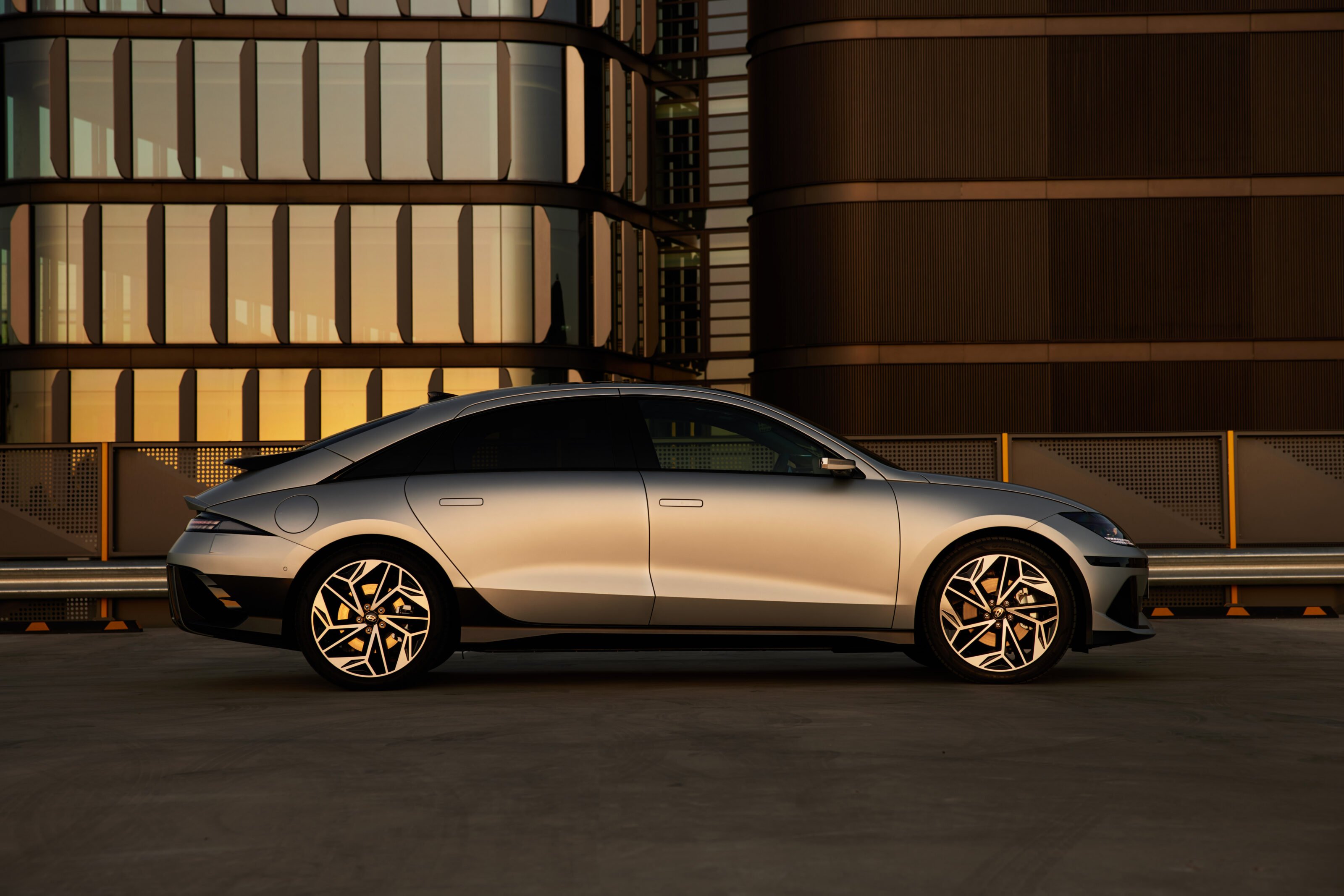
If, having overcome all of the above, you do manage to drive your IONIQ 6 into something, there are seven airbags to help cushion the blow to body and pride. ANCAP stars? Five, naturally.

Warranty and running costs
You know the drill with Hyundai, right? Five year, unlimited kilometre warranty. But let’s have a look at a few other details.
Aftersales and support can be provided by the (currently) 80-odd Hyundai Blue Drive dealerships across Australia.
There’s a fixed-price servicing plan available for the IONIQ 6 which will cost you $560 for the 24 month/30,000 kilometres and then another $560 for 48 months/60,000km. This also includes Premium Roadside Support and Satnav Update Plan.
The battery’s covered under a separate 8-year/1260,000km warranty with a 48 month/60,000km scheme.
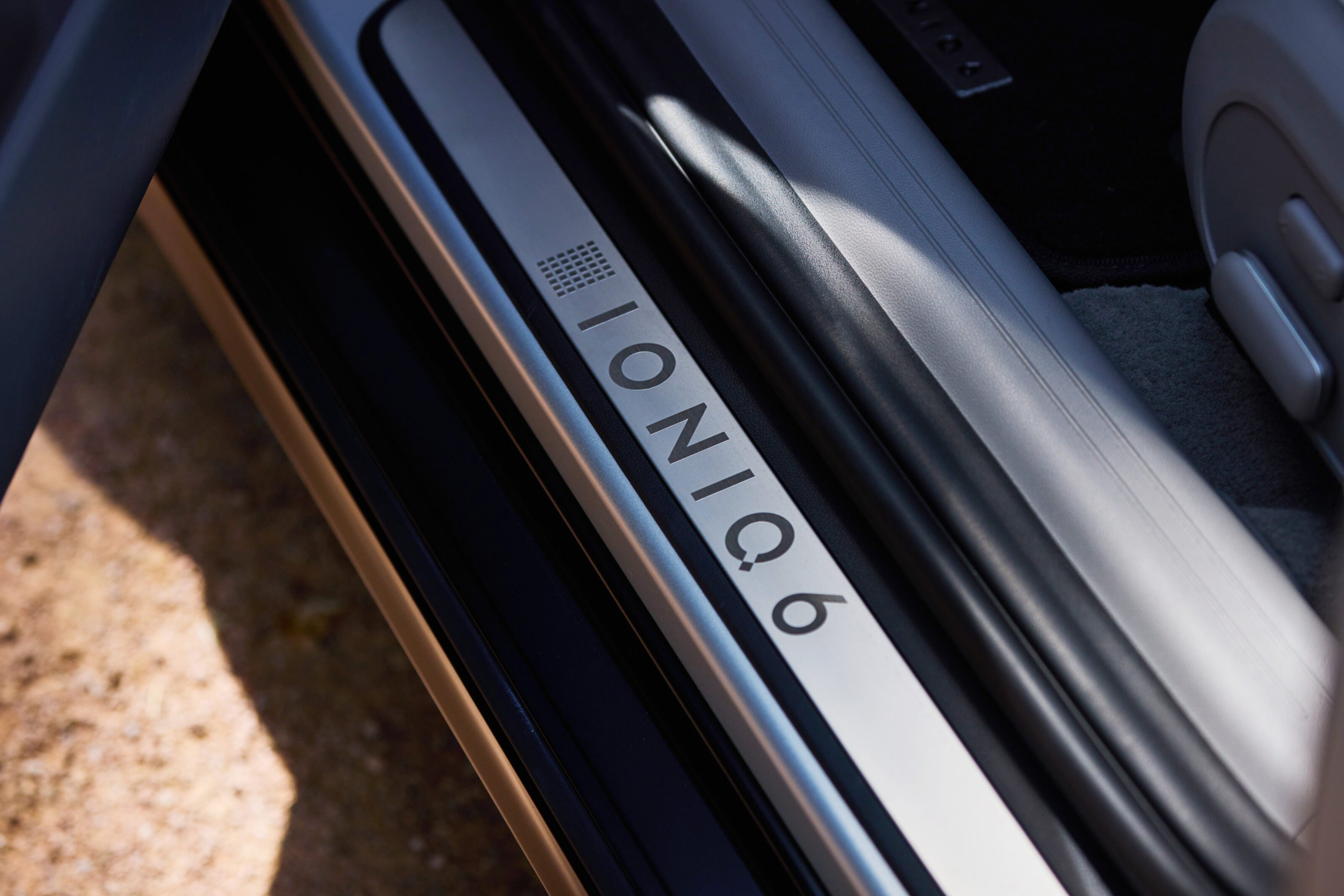
VERDICT
It seems banal, but the success of the Hyundai IONIQ 6 may well hinge on how well its styling is received.
While there was near-universal acclaim for the IONIQ 5’s shape, the 6 seems a far more divisive piece of design. We heard everything from long wheelbase Beetle to modern Tatra, Porsche 996 and Korean AU Falcon and many points in between. It’s an interesting, complex shape that never quite settles on the eye, changing its personality from different angles.
It’s hard to quibble with the engineering beneath, however. It’s a bigger, heavier, more technologically dense vehicle than a Tesla Model 3 and while there’s an argument that the Model 3 does more with what it has, the Hyundai just does more full stop. Put simply, it feels a step or two forwards in terms of EV maturity than the Tesla Model 3.
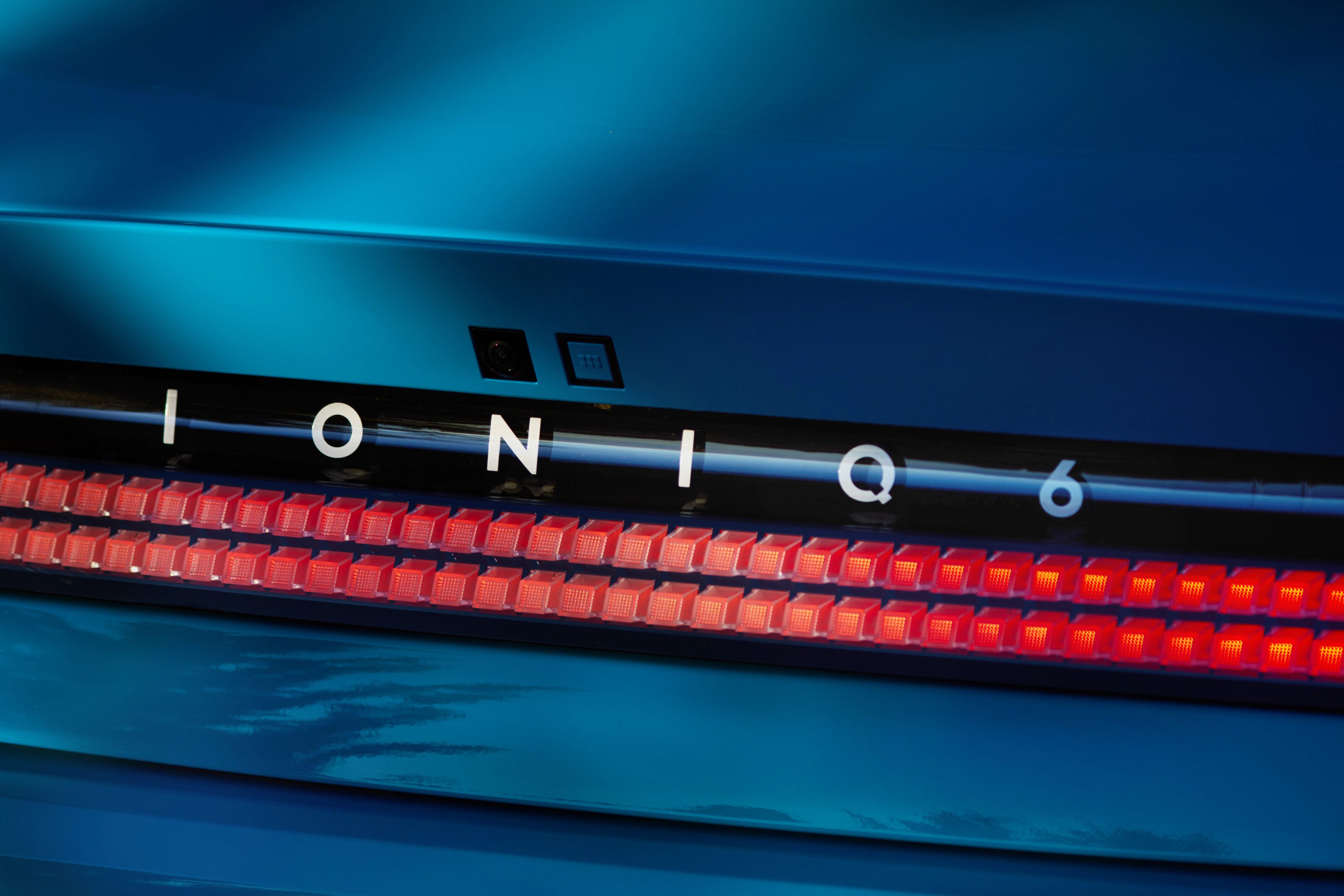
Critically, it’s also a far more comfortable car to drive and be driven in. The lack of local suspension tuning for the IONIQ 5 SUV was probably enough to prevent it beating Kia’s EV6 in Wheels’ 2022 Car of the Year award. It’s really not an issue with the IONIQ 6, which features a far more sophisticated suspension set up than that first batch of IONIQ 5s.
There are some minor annoyances such as the wired smartphone connection, the intrusive driver assists and the prescriptive range structure, but the IONIQ 6 gets so much else right that it emerges as a thoroughly likeable thing. That’s all very well, but doesn’t mean a whole lot if you can’t actually buy one.
Thankfully, Hyundai is optimistic about supply easing up, with four times the amount of IONIQ cars arriving this year compared to last, with 2024 seeing another doubling of supply.
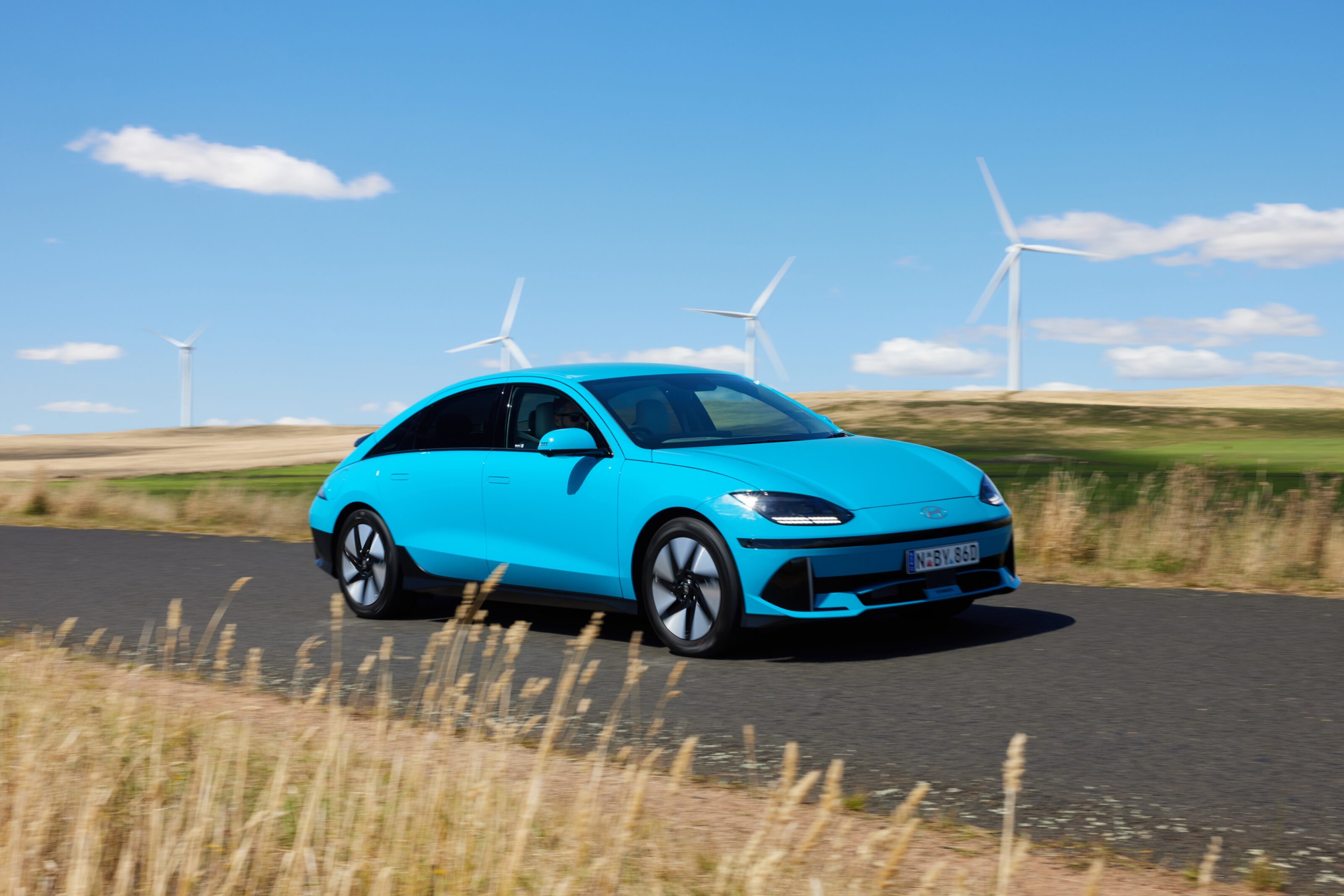
Unlike the IONIQ 5, which only went to a handful of dealers, the 6 can be ordered from the website to more than 80 Hyundai dealers across the country.
That’s not going to be enough to see the IONIQ 6 depose the Tesla Model 3 in the sales charts. Some will see that as the ultimate arbiter of success, and with some justification. Nevertheless, if you want the better car, right now it comes from Korea.
Specifications
| 2023 Hyundai IONIQ 6 Techniq | ||
|---|---|---|
| Motor | Dual permanent magnet synchronous | |
| Poweru00a0 | 239kW (74kW front, 165kW rear) | |
| Torqueu00a0 | 605Nm | |
| Transmission | Single-speed reduction gear | |
| Body | Four-door, five-seat medium sedan | |
| L/W/H | 4855/1880/1495mm | |
| Wheelbase | 2950mm | |
| Boot space | 401L | |
| Weight | 2078 kg (tare) | |
| Fuel use L/100km | 15.8kWh/100km (on test) | |
| Suspension | Front: MacPherson struts, coil springs, anti-roll bar / Rear: multi-link, coil springs, anti-roll bar | |
| Steering | electric rack-and-pinion; 11.82m turning circleu00a0 | |
| Brakes | 325 mm ventilated discs (f) 325mm solid discsu00a0 (r) | |
| Wheels | 20-inch, 8.5-inch width | |
| Tyres | Pirelli P Zero | |
| Tyre size & spare | 245/40R20 99Y f/r, mobility kit – no spare | |
⚡ More EV stories to help you choose the best car for your needs
Score breakdown
Things we like
- Overall refinement
- Ultra-fast charging
- Richly equipped
- Huge safety suite across all models
Not so much
- Pinched rear headroom
- Wired phone mirroring
- Intrusive driver aids
- Inflexible trim structure
We recommend
-
 Reviews
Reviews2023 Hyundai IONIQ 6 review: First drive
Hyundai’s “electrified streamliner” packs a punch, but in a bit of a heavyweight way
-
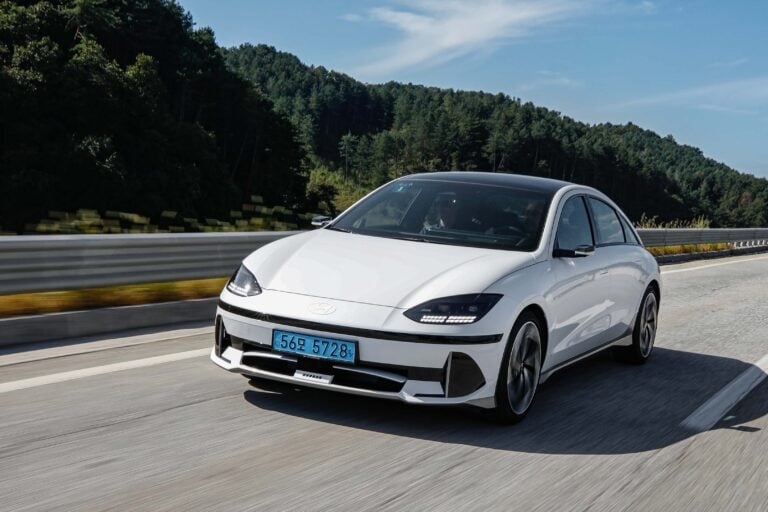 News
News2023 Hyundai Ioniq 6 pricing and features
Hyundai has confirmed details for its all-electric Ioniq 6 sedan due to launch in Australia this month – and it has the popular Tesla Model 3 in its sights
-
 News
NewsNew car calendar 2026: All the new cars coming to Australia next year
Here’s the WhichCar by Wheels guide to all the new cars that will launch in Australia in 2026. Check back in regularly for updates...


